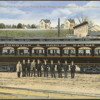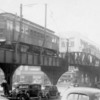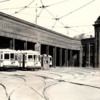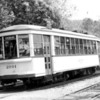Like this motor - open platform w/o a door for the motorman....some sort of 4-wheel(?) trailer behind it. Nice!

Chi Cag O

Attachments
Latrobe Street Rwy #52 in 1903

My grandfather at the Arlington Avenue loop in Mt. Oliver. He was on the chamber of commerce who pushed for the loop so when the loop opened he was there for the inaugural run.
Here is a picture dated March 28, 1947. The time is 9:30am. The picture is of my late grandfather Conrad opening the 48 Arlington loop of the Pittsburgh Railway Trolley Co. The car number was 1151.

In 1947 I was living in a 4 room apt. on Brownsville Rd in Mt. Oliver. Housing shortage after WW II. Possibly saw your grandfather. Got my Lionel Scout set then. Those were the days !! Went to the Mt. Oliver school on Hays Ave. and my grandparents lived in Knoxville.
jim pastorius posted:In 1947 I was living in a 4 room apt. on Brownsville Rd in Mt. Oliver. Housing shortage after WW II. Possibly saw your grandfather. Got my Lionel Scout set then. Those were the days !! Went to the Mt. Oliver school on Hays Ave. and my grandparents lived in Knoxville.
My grandfather lived on Arlington avenue just down from where the fire house is now. He was a commander of the VFW on Arlington Ave. I wish I had more time with him. He passed when I was 11. My dad worked at the Harris theater. I bet you went there a time to two.
MartyE posted:My grandfather at the Arlington Avenue loop in Mt. Oliver. He was on the chamber of commerce who pushed for the loop so when the loop opened he was there for the inaugural run.
Here is a picture dated March 28, 1947. The time is 9:30am. The picture is of my late grandfather Conrad opening the 48 Arlington loop of the Pittsburgh Railway Trolley Co. The car number was 1151.
Marty,
That loop was very important as it enabled Pittsburgh Railways to run PCC cars on that route. I lived in Carrick and rode the 53, 47 and 77/54 along Brownsville Road through Mt. Oliver. I liked riding the 47 as it turned onto Arlington Ave and followed the same route as the 48 to downtown through the South Hills Junction and the tunnel. That included the short jog through the grass between two homes the photo of which I posted earlier in this thread.
Bill
Chester & Media Electric Rwy

York Utilities Co in Sanford, ME in 1935

In New York City, there were dedicated trolley lines that ran on the bridges connecting Long Island and Manhattan.

Williamsburg Bridge Car

Queensborough Bridge Car

Williamsburg Bridge Car

Delancy Street Terminal For Brooklyn Bridge Cars
Attachments
Continuing with trolley cars in New York State.
Ithaca, New York
Jamestown, New York
Rochester, New York
Rochester, New York
Waterford, New York
Attachments

The Wachusett Reservoir, Westminster, Massachusetts back when postcards were one cent. This location looks nearly identical today -- except for the trolley.
Tomlinson Run Railroad
Attachments
Nice !!
West Penn Rwys Trolley Crane

Considering paint schemes, Connecticut Electric cars wore what I consider to be tied for the best, and right up there with the Johnstown cars.




Credit for these wonderful photos goes to the fantastic trolley museums in Connecticut at Warehouse Point and in Branford.
Attachments
A little mishap on the Phila & Easton Electric Rwy near Doylestown, Pa


As a kid, I waited there with my family a few times but not this early !! I think it is light rail now.
Market Street, Philadelphia, PA. Postmarked 1907.

Tomlinson Run Railroad
Attachments
Nice. I have a similar one of a Pittsburgh street.
A friend shared some photos of the Charlotte Trolley . Its now in operation running from Uptown to the Presbyterian Hospital. Construction is underway to extend the line. Right now you can ride the cars free of charge.
Here is the start of the route. The LYNX station, light rail is in the background.
At the Hospital end of the line.
Reaady for the run back uptown
Uptown Charlotte on the way to the Hospital
Coming off of Elizabeth Avenue heading to the Lynx Station.
So how about a couple of pics of the light rail , LYNX . The Charlotte Transit agency 's acronym is CATS for the Charlotte Area Transportation System . So the Light rail is appropriately named LYNX , one of the cats.
The sytem right now connects South Charlotte at the interstate and runs into uptown Charlotte. Travel time is about 20 minutes . Outside of the city area , it travels more like an interurban and signals at crossings with a steam sounding whistle. Within the city, speeds much slower and signals at crossings with a clanging bell
Attachments
Attachments
Attachments
Attachments
Philadelphia & Easton Electric Rwy Work Car

I have a fascination for the trolley lines that operated in Saratoga, New York. A few weeks ago I visited the old trolley depot which still stands in excellent condition, in use as the visitors center. Around the back of the building, the original canopies that the trolley cars entered still stand. After searching for a long time, I finally found a picture of the depot with trolley cars.
The trolley cars in the pictures belong to the Hudson Valley Railway and the Schenectady Railway Co.
It appears the photos of the depot were taken from Franklin, between Congress Street and West Circular Drive. Cars from this depot went north to Wilton, Glen Falls and Lake George, southwest to Ballston Spa and Schenectady, south to the Albany Capital District and Troy. There were branch lines to the race track and Kandeross Park.
Perhaps a local railroader can shed some info about this trolley depot. Below are some of the cars that ran into the Saratoga Depot.

Schenectady Car 502

Hudson Valley Car 37
Attachments
Bobby Ogage,
Great post. I too am a fan of the Saratoga Springs Visitor's Center, er, trolley station. I used to live there and used to return there for vacations. I may have a 35 mm color photo or two. If I find any, I'll scan them.
Also, I may have some architecture books/brochures. The brochures are more likely cover the station, 'though.
Tomlinson Run Railroad
For some good reading about the Hudson Valley Railway there is a book, "Saratoga Through Car, A History of The Hudson Valley Railway." I just bought one from Amazon.com, and there are some on eBay. Note the cover photo. You can see the front of the Saratoga depot to the right of the car.

Attachments
LIRR Steamer posted:A friend shared some photos of the Charlotte Trolley . Its now in operation running from Uptown to the Presbyterian Hospital. Construction is underway to extend the line. Right now you can ride the cars free of charge.
Here is the start of the route. The LYNX station, light rail is in the background.
At the Hospital end of the line.
Reaady for the run back uptown
Uptown Charlotte on the way to the Hospital
Coming off of Elizabeth Avenue heading to the Lynx Station.
So how about a couple of pics of the light rail , LYNX . The Charlotte Transit agency 's acronym is CATS for the Charlotte Area Transportation System . So the Light rail is appropriately named LYNX , one of the cats.
The sytem right now connects South Charlotte at the interstate and runs into uptown Charlotte. Travel time is about 20 minutes . Outside of the city area , it travels more like an interurban and signals at crossings with a steam sounding whistle. Within the city, speeds much slower and signals at crossings with a clanging bell
Interesting that the newly built vintage-looking streetcars have pantographs instead of trolley poles like actual vintage streetcars!
Bill
When the Trolleys were first in service. they ran on part of the current Lynx line from Uptown Charlotte to a location a bit south of the Belk Freeway. When the Lynx system began full operations, The trolleys ran jointly with the Links Light rail on weekends. So I guess that is whty they have pantographs , to allow them to operate from the same catenary
Back to that little incident on the Philadelphia & Easton

I love the cribbing !! "We don't need no stinking crane !! "
LIRR Steamer posted:When the Trolleys were first in service. they ran on part of the current Lynx line from Uptown Charlotte to a location a bit south of the Belk Freeway. When the Lynx system began full operations, The trolleys ran jointly with the Links Light rail on weekends. So I guess that is whty they have pantographs , to allow them to operate from the same catenary
That makes sense. Thanks for the explanation.
Bill
Cumberland Electric Rwy Co Trolleys

mwb posted:Cumberland Electric Rwy Co Trolleys
Nice "before" and "after" photos. Somebody had some real foresight taking that photo.
Tomlinson Run RR
Does anyone know where the Cumberland Electric Railways was located ??
Many thanks. A familiar story it seems.
Potomac Edison Co Trolley at Cumberland MD

I just finished reading three fantastic books about trolley car systems:
New York & North Shore Traction Company by Vincent F. Seyfried;
New York & Long Island Traction Company by Vincent F. Seyfried;
A History Of The Hudson Valley Railway, Saratoga Through Car by David F. Nestle.
These books are available on the used book market, and they are great reading about rise and fall of interurban systems in the period of 1895 through 1928. I find it incredible that so many efficient electric railways were squandered away.
My next search is for a copy of the Long Island Electric Company by Vincent F. Seyfried. Ironically, Mr Seyfried was my English teacher in Martin Van Buren High School, but I had no idea of his interest in trolley car lines at the time.
For the record, I discovered in "A History Of The Hudson Valley Railway, Saratoga Through Car" by David F. Nestle that this mishap took place in Mechanicville, New York. The car was a runaway down that went down Park Avenue in Mechanicville.

Attachments
Although the New York & Long Island Traction (NY&LIT) Company's rolling stock long ago perished, one car that operated over the line has survived because it was a BRT (Brooklyn Rapid Transit) car that was converted it into a sand car, No. 9730, and purchased by the Branford Trolley Museum in 1950. Members of the Branford Museum did a great job of restoring the car back into her BRT 1792 configuration.
Built for the BRT by the Laclede Car Company of St. Louis in 1899, No. 1792 on loan to the NY&LIT, once operated through Long Island towns such as Rosedale, Springfield, Lynbrook, Baldwin, Freeport, Hempstead, Garden City, Mineola and along the Jamaica Avenue Branch (AKA Jericho Turnpike) through Queens Village, Bellerose, Floral Park and New Hyde Park.
Sole Surviving Car That Operated On The New York & Long Island Traction Company's Railways
Attachments
Bobby Ogage posted:
New York & North Shore Traction Company Car southbound to Mineola. This is likely a Kuhlman built car. The Roslyn Clock Tower was a trolley stop and the tower still stands today.
This may be the same car northbound to Port Washington. It is about to climb a hill and cross Northern Boulevard (Rt 25A).
Have any Kuhlman cars of the early 1900s been saved?
Great photos Bobby! I used to live not very far from the old town of Roslyn, NY. and this photo brought back memories of many good times. Looking at the top photo, if you went down the road to the right, which goes down hill and is a one way street, you would be at the Roslyn movie theater. Also many interesting shops, cafes and lots of history to be found in that town too. The clock tower still stands today and was a memorial to Ellen E. Ward, which was built in 1895.
Trolley on West 4th Street, Williamsport, PA. Postmarked: 1910.
Tomlinson Run Railroad
Attachments
Cumberland Electric Rwy Co Trolley Car Barn

Once upon a time there was a street railway that ran along the Rockaways which are the south shore beach communities of Long Island. Like the fate of most of the trolley lines on Long Island, the Ocean Beach Railway wound up under the control of the Long Island Rail Road.
Ocean Electric Car 3211
The Ocean Electric Railway Had Trackage Rights On The Long Island Rail Road In The Rockaways
Brill Built Convertible No. 21
Attachments
Trolley & Conductors at Northumberland, Pa


Sunbury & Northumberland Trolley and Conductors



When street cars ruled in Detroit.

The yard in Highland Park off of Woodland Avenue in 1936.

This is the Twin City Rapid Transit yard in Minneapolis.

New Orleans Canal Yard in 1955.
Attachments
MWB,
Your last two posts with the close-ups of the conductors and their uniforms is a nice idea. It really brings it home that those fellows were somebody's father, husband, uncle, grandfather. They all look so proud of their cars, too.
Tomlinson Run Railroad
Attachments
What they look like before restoration. The lucky ones!
Chicago Surface Lines 1137
Jacksonville Traction Car
Rochester Subway 60
West Shore Electric 151
Attachments
TomlinsonRunRR posted:MWB,
Your last two posts with the close-ups of the conductors and their uniforms is a nice idea. It really brings it home that those fellows were somebody's father, husband, uncle, grandfather. They all look so proud of their cars, too.
Tomlinson Run Railroad
Thanks! While the trolleys alone are very interesting, they were a part of the lives of people then. Those old photos and RPPC's capture interesting people that are a part of our past and everything about them adds both detail and information pertaining to the times. I have a few more that I managed to find and expand that I will post up in the near future.
Once upon a time a trolley ran through the Delaware Water Gap from Stroudsburg to Portland in Pennsylvania. I am unable to find a map of the right of way for the Stroudsburg & Water Gap Ry. Does anyone know where this railway right of was?
I think that this road may be Rt 611
Attachments
Gentlemen,
Thanks for the memories!
PCRR/Dave
mwb posted:Sunbury & Northumberland Trolley and Conductors
Interesting — one has a coat that buttons on the 'right' side, the other has a coat that buttons on the 'left' side.
I wonder why the differences.
Ron M
ron m posted:Interesting — one has a coat that buttons on the 'right' side, the other has a coat that buttons on the 'left' side.
I wonder why the differences.
Ron M
No idea. Maybe you had to supply your own uniforms and that was not specified? Maybe one guy is left handed?
Some more of the Sunbury & Northumberland and 3 Conductors



Now we're all gonna be looking at how their jackets are buttoned ... :-).
TRRR
TomlinsonRunRR posted:Now we're all gonna be looking at how their jackets are buttoned ... :-).
TRRR
Those 3 guys are a real bundle of joy, too.
mwb posted:TomlinsonRunRR posted:Now we're all gonna be looking at how their jackets are buttoned ... :-).
TRRR
Those 3 guys are a real bundle of joy, too.
=grin= Yeah, I noticed that, too. Maybe it was their last day on that line and it was a farewell photo?
TRRR
I think working for the trolley or interurban company was a good job in those days. A book I have gave the wages for a company in Pa.
Attachments
Here are 2 photos of Pittsburgh Railways #3487, a Double Truck, Double End High Floor Car built by St. Louis Car Company in 1905. This car has been preserved and is on display at the Pennsylvania Trolley Museum. The first photo from the PTM website shows it in service on the #13 Emsworth Route around 1909. The second photo shows it at the Museum as pictured on a postcard during the early years of the Museum.
And now that we’re focusing on uniforms, note that the conductor and motorman’s jackets appear to button down the middle but with the left side on the outside.
Bill
Attachments
Still on the Sunbury & Northumberland.....nice little single truck open car!




When I lived in Little Rock back in 1979 - 1982, there was no trolley system or talk of one. Since I left town, look what was sprung up. The cars appear to be newly built by Gomaco.
Attachments
It was standing room only on this Pittsburgh Railways Street Car on a July afternoon in the early 1900’s at Kennywood Park. Back in those days that was how most park visitors arrived at and returned home from the park. Note the long dresses and suit on the man. Back then this park had to compete with 13 other “trolley parks” in the Pittsburgh area for customers. And among those 13 trolley parks, only Kennywood survived!
Many years later than this photo I rode PCC streetcars to Kennywood when I was a kid. I also rode a passenger train with my grandparent's to Idlewild Park in Ligonier as my grandfather worked for the Pennsy and had a pass. BTW Idlewild also survives to this day but it was not a trolley park having been started by the Ligonier Valley Railroad, a short narrow gauge coal-hauling railroad. Bill
Attachments
Bill,
What a great Kennywood photo and back story. Kennywood was a stop for my family but I seem to recall that we drove but then often went with extended family/friends. My mother's generation went to Ligonier, also on PRR passes. Small world.
Tomlinson Run Railroad
Trolley parks were once prolific and predominately on the east side of the Mississippi River. Here's a link to the history of trolley parks, and it includes lists of trolley parks still operating and those that went out of business.
Between this thread and the diner car thread, if you are not following Brian Butko on Facebook and some of his groups, you are missing out on a lot of stuff.
I don't know how much trolley content will be in it, but his book on Luna Park in Pittsburgh is dropping now.
Trolley cars at or in route to parks.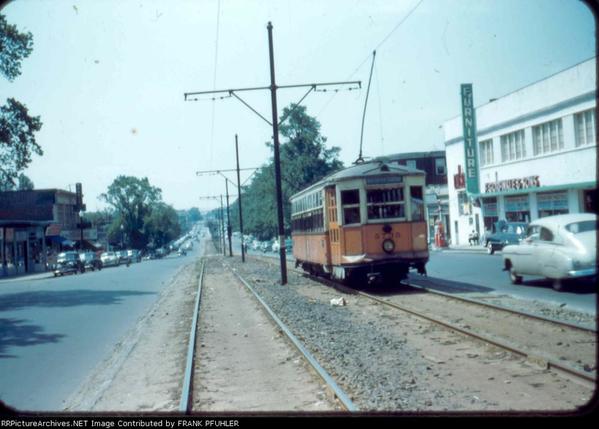 On The Way Up Blue Hill Avenue, Dorchester Towards Franklin Park
On The Way Up Blue Hill Avenue, Dorchester Towards Franklin Park
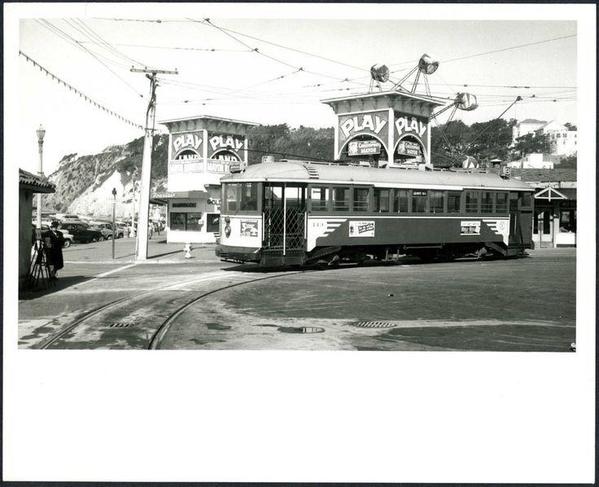 1955 SAN FRANCISCO @ PLAYLAND AMUSEMENT PARK
1955 SAN FRANCISCO @ PLAYLAND AMUSEMENT PARK
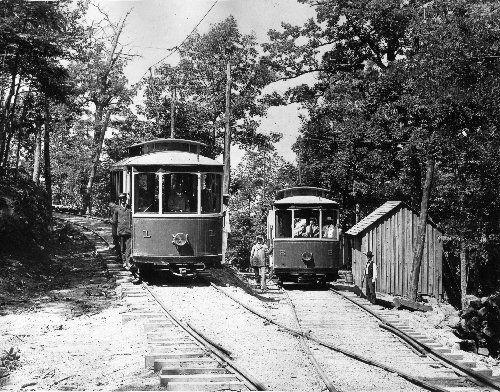 Asheville & Craggy Mountain Railway Cars On Sunset Mountain In Route To Overlook Park
Asheville & Craggy Mountain Railway Cars On Sunset Mountain In Route To Overlook Park
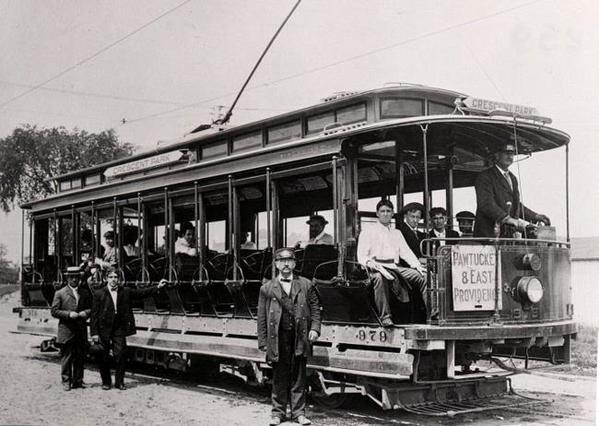 AT RIVERSIDE, Rhode Island 1910 Going TO CRESCENT PARK
AT RIVERSIDE, Rhode Island 1910 Going TO CRESCENT PARK
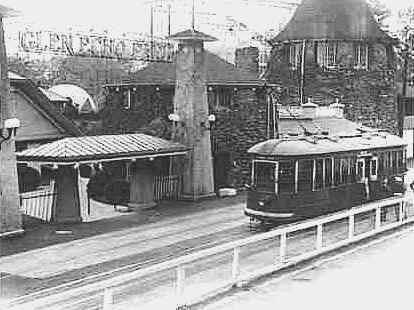 Glen Echo Park
Glen Echo Park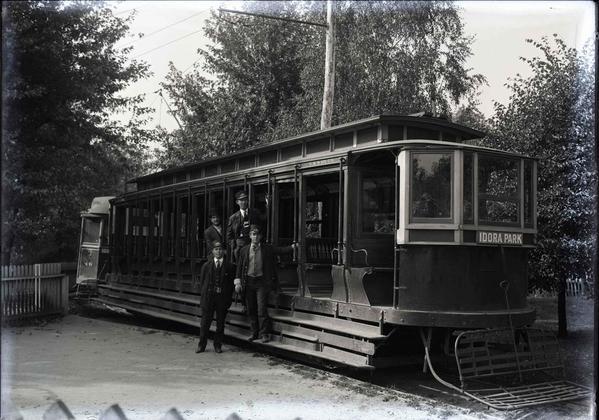 Idora Park Trolley
Idora Park Trolley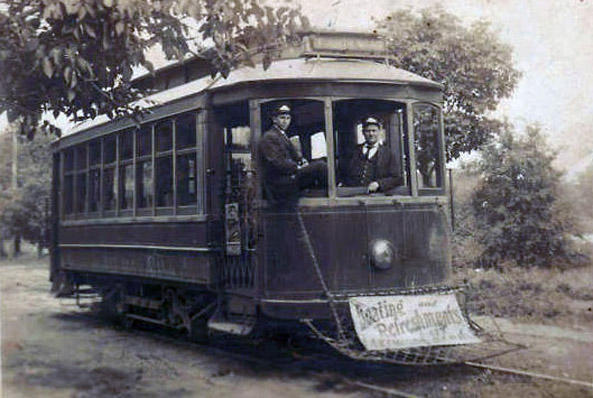 Lakewood-Park-1910, Charlotte, NC
Lakewood-Park-1910, Charlotte, NC
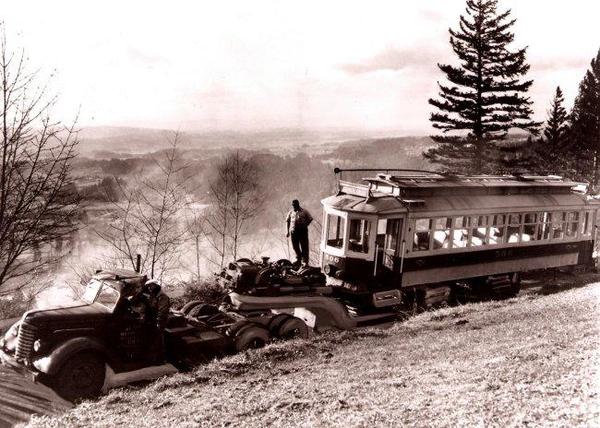
Portland 506 was hauled up to Council Crest Park on Nov. 22, 1950 and it stayed there till vandals damaged it on Halloween night in 1972
Trolley Cars @ Washington Park, Westville, NJ
Attachments
Greg Nagy posted:Between this thread and the diner car thread, if you are not following Brian Butko on Facebook and some of his groups, you are missing out on a lot of stuff.
I don't know how much trolley content will be in it, but his book on Luna Park in Pittsburgh is dropping now.
Greg,
Yes, Brian Butko has done a good job of picking up the torch from Randy Garbin, Richard Gutman, and others who photograph, record, and track diner buildings. I avoid Facebook, but Mr. Garbin has a useful web blog. Is there another O gauge diner car thread out there that I missed? We've had several here and I do hope to post some new information to my trolley-railcar-diner "the real story" post -- this weekend in fact, as it's been a while (too busy!).
Thanks for the heads up on the book release.
Tomlinson Run RR
I was reading a book on NW Pa.RRs and there was a photo of a dining car which they said went to Fredonia, Pa and made in to a diner. Any record of this ??
TomlinsonRunRR posted:Greg Nagy posted:Between this thread and the diner car thread, if you are not following Brian Butko on Facebook and some of his groups, you are missing out on a lot of stuff.
I don't know how much trolley content will be in it, but his book on Luna Park in Pittsburgh is dropping now.
Greg,
Yes, Brian Butko has done a good job of picking up the torch from Randy Garbin, Richard Gutman, and others who photograph, record, and track diner buildings. I avoid Facebook, but Mr. Garbin has a useful web blog. Is there another O gauge diner car thread out there that I missed? We've had several here and I do hope to post some new information to my trolley-railcar-diner "the real story" post -- this weekend in fact, as it's been a while (too busy!).
Thanks for the heads up on the book release.
Tomlinson Run RR
And for us Pittsburgers Brian also wrote books on Kennywood and Isaly's.
Bill
jim pastorius posted:I was reading a book on NW Pa.RRs and there was a photo of a dining car which they said went to Fredonia, Pa and made in to a diner. Any record of this ??
So, Jim, this is a puzzle! The "transportation"-related restaurant that I'm aware of in Fredonia, PA is a former Kuhlman 700-Series trolley now "serving" (ha!) as the Coach Dinor [sic]. Because I promised to update my trolley-railcar-diner post this weekend, I've explored this trolley-diner and your question in more detail there. It's got a link to a better quality copyrighted photo, too. Thanks for giving me a good and easy topic to work on this weekend! Meanwhile, here's a Google-snap of the Coach Dinor:

SO -- if the Coach Dinor is a Kuhlman trolley that still begs the question of what is your book talking about when it shows a photo of a "dining car" turned restaurant? Feel free to reply at the other link if it's a railcar rather than a trolley.
Tomlinson Run Railroad
Attachments
Bobby Ogage posted:
Ah! The Berkshire Hills is my favorite trolley! (To date anyway.) It too spent its retirement years as a restaurant and what is left of it is now in storage at the Seashore Trolley Museum. For those interested, here's a post that I did a while ago with links to additional photos that I found on the internet. Stunning workmanship and an interesting "parlor" design. The curved ends intrigued me.
Tomlinson Run Railroad
As mentioned trolley car companies promoted amusement parks at the end of their lines. The parks utilized the electric power from the trolleys to operate their rides and attractions. Many photos and stories have appeared on this subject. In 1845 an amusement park opened in Bristol / Southington Connecticut. When the electric trolley line was constructed it services the park. Through the years the park changed hands a few times. It had its ups and downs (not only on the rides). Trolley service to the park ended and a narrow gauge railroad was provided around the site. Around twenty years ago a new owner started to rehabilitate the park. They struck a deal with the Shore Line Trolley Museum in Branford Conn. A right of way was constructed and an Olgood Bradley open bench trolley was sent to the park. It has been operating there ever since. I and going to try and attach some photos to this. For a lot more information go to Wikapedia, the Lake Compounce amusement park or the Shore Line Trolley museum. Better still, take a trip this summer and visit both attractions. The parliament boasts a world class wooden roller coaster and many other attractions and the museum has many operating trolleys and transit cars.




 D
D
Attachments
Down at Big Boy's Gas Station

mwb posted:Down at Big Boy's Gas Station
MWB, That is an incredible photo that is just screaming to be modeled! Here's the back story.
Thanks for posting. This is going to be my new screen saver.
Tomlinson Run Railroad
Love the car at the pumps. A cousin to my 1937 Chevy, my first car while in college. Cost me $65 but could hardly afford to run it. Bought it 1955. 18 yrs old, now I drive a GMC Jimmy 16 yrs old so I have bettered myself by two years. !!
Trolley car and track workers in Framingham

I magnified the picture of the track workers in Framingham, and it appears that ties are being replaced in the siding. That track gang has a lot of people doing nothing. At the far right, the workers have their jackets hung on gravestones.
What is that "U" shaped gizmo in the forefront of the picture, and on the right rail?
Bobby Ogage posted:I magnified the picture of the track workers in Framingham, and it appears that ties are being replaced in the siding. That track gang has a lot of people doing nothing.
Some things have never changed over the years - I see this every day on the way home; lanes closed and lots of guys standing around while 1-2 are actually working.......but everybody has to stop for a photo opp,
At the far right, the workers have their jackets hung on gravestones.
Can you imagine the screaming were that to happen today?
What is that "U" shaped gizmo in the forefront of the picture, and on the right rail?
Think that might be an anchor driven into the ground to hold the rail in place while the ties are being replaced?
Nate posted:As mentioned trolley car companies promoted amusement parks at the end of their lines. The parks utilized the electric power from the trolleys to operate their rides and attractions. Many photos and stories have appeared on this subject. In 1845 an amusement park opened in Bristol / Southington Connecticut. When the electric trolley line was constructed it services the park. Through the years the park changed hands a few times. It had its ups and downs (not only on the rides). Trolley service to the park ended and a narrow gauge railroad was provided around the site. Around twenty years ago a new owner started to rehabilitate the park. They struck a deal with the Shore Line Trolley Museum in Branford Conn. A right of way was constructed and an Olgood Bradley open bench trolley was sent to the park. It has been operating there ever since. I and going to try and attach some photos to this. For a lot more information go to Wikapedia, the Lake Compounce amusement park or the Shore Line Trolley museum. Better still, take a trip this summer and visit both attractions. The parliament boasts a world class wooden roller coaster and many other attractions and the museum has many operating trolleys and transit cars.
D
Nice photos and that’s a different twist on the "trolley park" concept – instead of the trolley company building the park, this park was there many years before the trolley line was added. Plus it’s still there today and you can ride a restored trolley to visit it!
Bill
mwb posted:Think that might be an anchor driven into the ground to hold the rail in place while the ties are being replaced?
I think it's for putting spike starter holes in the ties.
Sacramento Northern 1005 at the Western Railway Museum. It is operating on the former Sacramento Northern mainline, now part of the Western Railway Museum. The other two cars in the train are SN 1020 and Salt Lake and Utah observation 751. 751 is a control trailer. The train will be run from the 751 on the return trip. 
Attachments
Attachments
https://www.streetcar.org/stre...on-elevated-railway/
It's ironic how everyone loves old SEPTA PCCs. Except SEPTA. ![]()
Mitch
Yes, and Pittsburgh too ! Pgh had the most of any city and kept none ! There is a stationary PCC in the Heinz History Center and one that runs(I think) at the trolley museum near Washington, Pa. The PCCs ran forever and they have bought replacements for them several times over.
jim pastorius posted:Yes, and Pittsburgh too ! Pgh had the most of any city and kept none ! There is a stationary PCC in the Heinz History Center and one that runs(I think) at the trolley museum near Washington, Pa. The PCCs ran forever and they have bought replacements for them several times over.
Hi Jim:
Yes indeed we had the most PCC cars in service in the USA in Pittsburgh for many years but unfortunately not the most ever of any US city. Before we hear from a Chicago member we were second to Chicago who had purchased just 17 more PCC cars than our total fleet of 666 PCC cars. However, the Chicago PCC streetcars had a relatively short career because in 1947 as their last order of PCC cars was arriving the decision was made to start replacing trolley lines with busses! It took 11 years to complete the conversion as the last Chicago PCC streetcar was taken out of service in 1958. Some of the newest PCC cars which were purchased early in 1947 barely had 10 years of operating time. OTOH, essentially all of Pittsburgh’s 666 PCC’s were still in service in 1958 (notable exceptions were the 14 PCC’s destroyed by fire at the Homewood Car Barn in 1955). So it’s safe to say we had the largest operating PCC fleet system in the USA from 1958 and many years thereafter.
Across the border in Canada, Toronto had more PCC’s than Pittsburgh or Chicago with 745 although they bought 205 of them used from Birmingham, Cincinnati, Cleveland & Kansas City when those cities abandoned streetcars.
That surviving car at the Pennsylvania Trolley Museum in “Little Washington” you mentioned is Pittsburgh Railways #1711 which is operational and there are also 3 other Pittsburgh PCC’s at the Museum including the last PCC to operate in revenue service in Pittsburgh in 1999 - PAT car #4004 which was a rebuilt 1700-series PCC, and it is also in operating condition. There are, or were, 2 other static Pittsburgh PCC cars sitting outdoors that I know of, one in Bethel Park and one at the PAT South Hills Village Station near the Mall.
And in response to Mitch’s posting, there are two former PTC/SEPTA PCC’s at the Museum, one of which is operational as seen in the attached photo with yours truly at the controls in 2011.
Bill
Attachments
SF & Napa Valley

I love some of the cars and equipment the old transit companies came up with. Dambach was a lumber dealer & cabinet shop in Evans City, Pa. and built some interurban car bodies for the Pgh, _Butler interurban line. they bought or used old power trucks.
WftTrains posted:jim pastorius posted:Yes, and Pittsburgh too ! Pgh had the most of any city and kept none ! There is a stationary PCC in the Heinz History Center and one that runs(I think) at the trolley museum near Washington, Pa. The PCCs ran forever and they have bought replacements for them several times over.
Hi Jim:
Yes indeed we had the most PCC cars in service in the USA in Pittsburgh for many years but unfortunately not the most ever of any US city. Before we hear from a Chicago member we were second to Chicago who had purchased just 17 more PCC cars than our total fleet of 666 PCC cars. However, the Chicago PCC streetcars had a relatively short career because in 1947 as their last order of PCC cars was arriving the decision was made to start replacing trolley lines with busses! It took 11 years to complete the conversion as the last Chicago PCC streetcar was taken out of service in 1958. Some of the newest PCC cars which were purchased early in 1947 barely had 10 years of operating time. OTOH, essentially all of Pittsburgh’s 666 PCC’s were still in service in 1958 (notable exceptions were the 14 PCC’s destroyed by fire at the Homewood Car Barn in 1955). So it’s safe to say we had the largest operating PCC fleet system in the USA from 1958 and many years thereafter.
Across the border in Canada, Toronto had more PCC’s than Pittsburgh or Chicago with 745 although they bought 205 of them used from Birmingham, Cincinnati, Cleveland & Kansas City when those cities abandoned streetcars.
That surviving car at the Pennsylvania Trolley Museum in “Little Washington” you mentioned is Pittsburgh Railways #1711 which is operational and there are also 3 other Pittsburgh PCC’s at the Museum including the last PCC to operate in revenue service in Pittsburgh in 1999 - PAT car #4004 which was a rebuilt 1700-series PCC, and it is also in operating condition. There are, or were, 2 other static Pittsburgh PCC cars sitting outdoors that I know of, one in Bethel Park and one at the PAT South Hills Village Station near the Mall.
And in response to Mitch’s posting, there are two former PTC/SEPTA PCC’s at the Museum, one of which is operational as seen in the attached photo with yours truly at the controls in 2011.
Bill
Bill,
What are the 3 PCC cars under wraps behind the old car barn? Parts or unlisted on the roster?
WftTrains posted:jim pastorius posted:Yes, and Pittsburgh too ! Pgh had the most of any city and kept none ! There is a stationary PCC in the Heinz History Center and one that runs(I think) at the trolley museum near Washington, Pa. The PCCs ran forever and they have bought replacements for them several times over.
Hi Jim:
Yes indeed we had the most PCC cars in service in the USA in Pittsburgh for many years but unfortunately not the most ever of any US city. Before we hear from a Chicago member we were second to Chicago who had purchased just 17 more PCC cars than our total fleet of 666 PCC cars. However, the Chicago PCC streetcars had a relatively short career because in 1947 as their last order of PCC cars was arriving the decision was made to start replacing trolley lines with busses! It took 11 years to complete the conversion as the last Chicago PCC streetcar was taken out of service in 1958. Some of the newest PCC cars which were purchased early in 1947 barely had 10 years of operating time. OTOH, essentially all of Pittsburgh’s 666 PCC’s were still in service in 1958 (notable exceptions were the 14 PCC’s destroyed by fire at the Homewood Car Barn in 1955). So it’s safe to say we had the largest operating PCC fleet system in the USA from 1958 and many years thereafter.
Across the border in Canada, Toronto had more PCC’s than Pittsburgh or Chicago with 745 although they bought 205 of them used from Birmingham, Cincinnati, Cleveland & Kansas City when those cities abandoned streetcars.
That surviving car at the Pennsylvania Trolley Museum in “Little Washington” you mentioned is Pittsburgh Railways #1711 which is operational and there are also 3 other Pittsburgh PCC’s at the Museum including the last PCC to operate in revenue service in Pittsburgh in 1999 - PAT car #4004 which was a rebuilt 1700-series PCC, and it is also in operating condition. There are, or were, 2 other static Pittsburgh PCC cars sitting outdoors that I know of, one in Bethel Park and one at the PAT South Hills Village Station near the Mall.
And in response to Mitch’s posting, there are two former PTC/SEPTA PCC’s at the Museum, one of which is operational as seen in the attached photo with yours truly at the controls in 2011.
Bill
Bill,
What are the 3 PCC cars under wraps behind the old car barn? Parts or unlisted on the roster?
Never mind: looks like cars 24, 1711 and 2723?
Attachments
Greg Nagy posted:WftTrains posted:jim pastorius posted:Yes, and Pittsburgh too ! Pgh had the most of any city and kept none ! There is a stationary PCC in the Heinz History Center and one that runs(I think) at the trolley museum near Washington, Pa. The PCCs ran forever and they have bought replacements for them several times over.
Hi Jim:
Yes indeed we had the most PCC cars in service in the USA in Pittsburgh for many years but unfortunately not the most ever of any US city. Before we hear from a Chicago member we were second to Chicago who had purchased just 17 more PCC cars than our total fleet of 666 PCC cars. However, the Chicago PCC streetcars had a relatively short career because in 1947 as their last order of PCC cars was arriving the decision was made to start replacing trolley lines with busses! It took 11 years to complete the conversion as the last Chicago PCC streetcar was taken out of service in 1958. Some of the newest PCC cars which were purchased early in 1947 barely had 10 years of operating time. OTOH, essentially all of Pittsburgh’s 666 PCC’s were still in service in 1958 (notable exceptions were the 14 PCC’s destroyed by fire at the Homewood Car Barn in 1955). So it’s safe to say we had the largest operating PCC fleet system in the USA from 1958 and many years thereafter.
Across the border in Canada, Toronto had more PCC’s than Pittsburgh or Chicago with 745 although they bought 205 of them used from Birmingham, Cincinnati, Cleveland & Kansas City when those cities abandoned streetcars.
That surviving car at the Pennsylvania Trolley Museum in “Little Washington” you mentioned is Pittsburgh Railways #1711 which is operational and there are also 3 other Pittsburgh PCC’s at the Museum including the last PCC to operate in revenue service in Pittsburgh in 1999 - PAT car #4004 which was a rebuilt 1700-series PCC, and it is also in operating condition. There are, or were, 2 other static Pittsburgh PCC cars sitting outdoors that I know of, one in Bethel Park and one at the PAT South Hills Village Station near the Mall.
And in response to Mitch’s posting, there are two former PTC/SEPTA PCC’s at the Museum, one of which is operational as seen in the attached photo with yours truly at the controls in 2011.
Bill
Bill,
What are the 3 PCC cars under wraps behind the old car barn? Parts or unlisted on the roster?
Never mind: looks like cars 24, 1711 and 2723?
Greg,
I agree with you on Septa #24 & 2723 but #1711 is in PTM's operating fleet and is stored indoors. Chances are that 3rd one is PAT PCC #1799 (× PRC 1613). I had forgotten about that car which means there are 5 Pittsburgh PCC's at the PA Trolley Museum, not 4 as I had posted above. Also #24 has much of the PCC styling but is actually not a PCC. BTW, there is also one more PCC at the PTM, it's Shaker Heights (Cleveland) #94, the only Pullman-built of the 8 PCC's at the museum.
Bill
Glad to hear the trolley museum has so many. I smile every time I see a photo of a nice PCC car. Just a beautiful classic design and so successful. I wish more things were that way.
NYS Rwys Utica Lines Construction Crane Trolley on the New Hartford Loop in 1935

Trolley cars to the beaches.
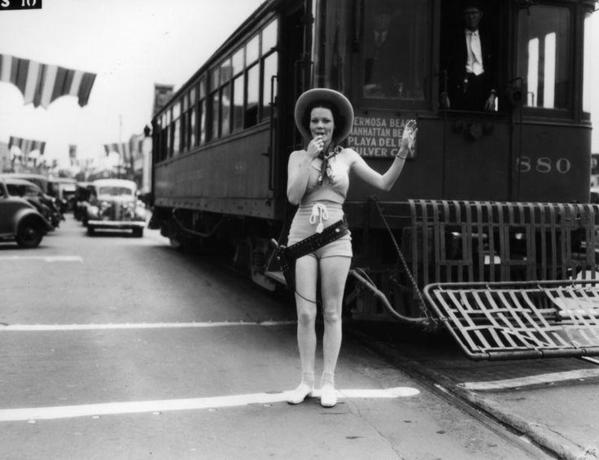
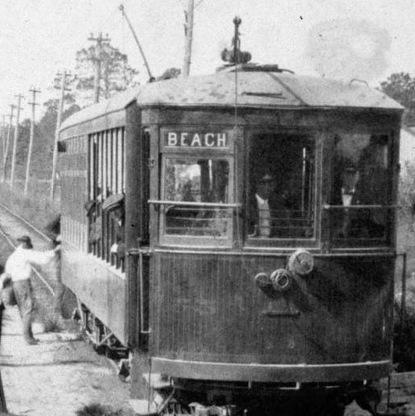 Delaware????
Delaware????
 Brighton Beach, Brooklyn
Brighton Beach, Brooklyn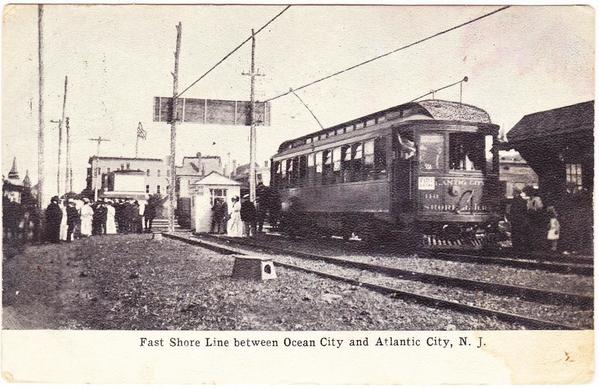
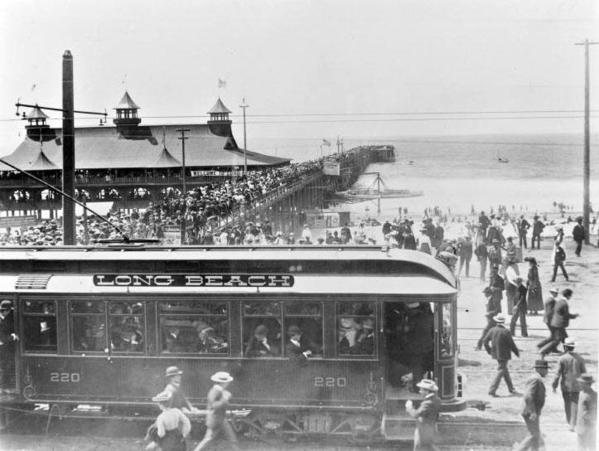
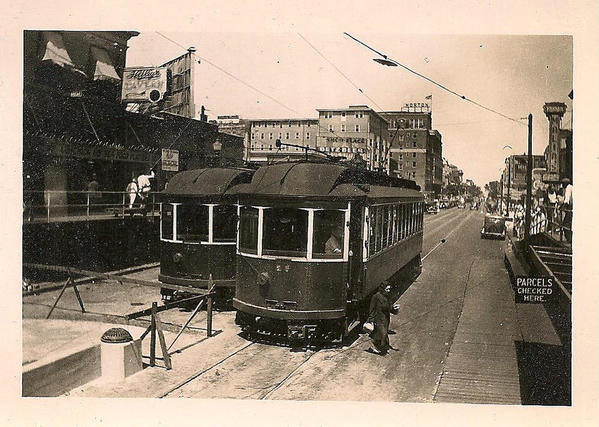 Atlantic City Shore Fast Line cars
Atlantic City Shore Fast Line cars
Attachments
Have an Atlantic City time capsule from December, 1940 celebrating the new Brilliners!
Mitch
Attachments
Portland Street RR Trolley Sand Car

Trolley cars in the barns.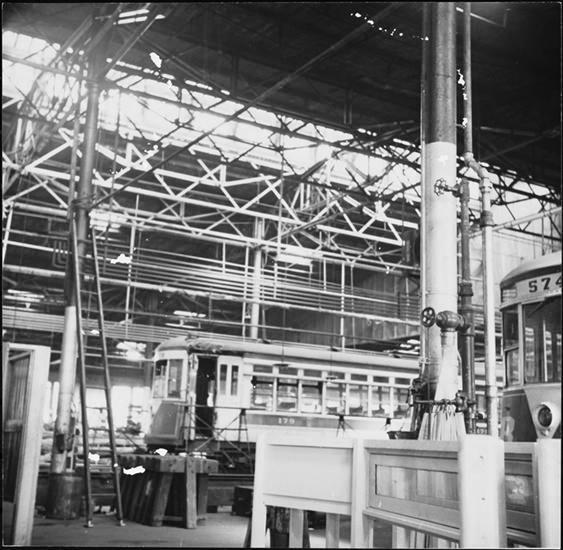 Third Avenue Railway, New York City
Third Avenue Railway, New York City
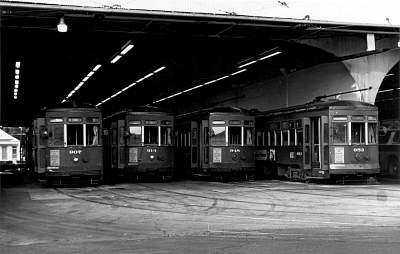
St. Charles Line, New Orleans
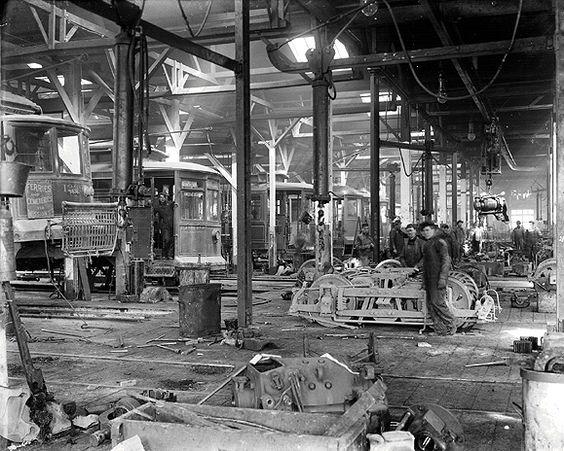 San Francisco, 1917
San Francisco, 1917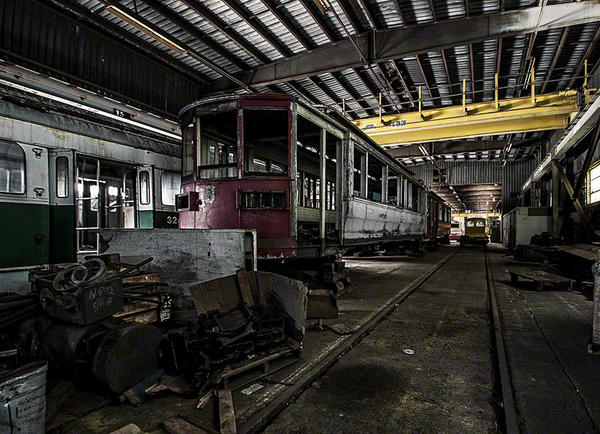 Somewhere In The East
Somewhere In The East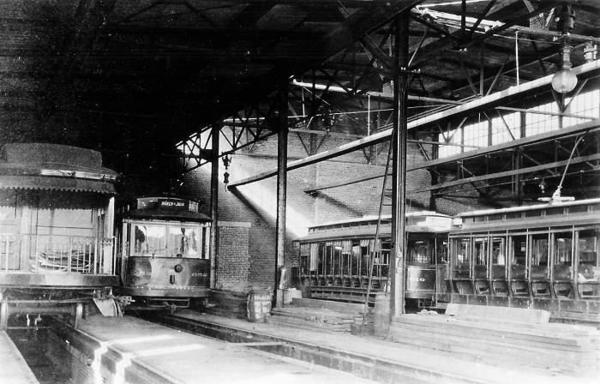 Champaign, Illinois
Champaign, Illinois
Attachments
The photo you have marked as San Francisic is the Market Street Railway's Elkton shops. It was located at the corner of Geneva and San Jose Avenues until about 1976. It was built as a temporary facility after the 1906 earthquake and fire. Clearly shown in the photo was the monorail crane that ran around the shop. It had a very small cab where the operator sat. I believe it is still in existence. There was no AC power in Elkton until very late. Just to the right of the photo was a 550 to 250 volt DC motor generator to provide power for the machines. There were many machines still powered by 250 VDC when the shop closed. The shop was very complete with a machine shop, blacksmith shop, foundry, wood mill and motor shop. Many cars were built complete there. In later years all the cable cars were rebuilt here. When I spent time there the bays were filled with PCC cars. Best part of Elkton was it had a basement. Never know what you might find there.
The photo marked some where in the east in interesting. Fairly modern building and crane. Looks like a Boston PCC on the left. I do not recognize the other cars. I wounder if it is Brookville Locomotive Works.
"Somewhere In The East" is the Trolley Graveyard in PA.
M. Mitchell Marmel posted:"Somewhere In The East" is the Trolley Graveyard in PA.
Mitch:
Are you sure? I thought the cars stored at Windber were only PCC’s and were all stored outdoors but Bobby’s photo shows an indoor barn with mostly non-PCC’s.
Bill
No, there's also some rapid transit cars rotting in the woods and the one barn where a lucky few cars are under shelter.
Metka thinks the bloody things are solid gold and is demanding something like a million bucks apiece.
M. Mitchell Marmel posted:No, there's also some rapid transit cars rotting in the woods and the one barn where a lucky few cars are under shelter.
Metka thinks the bloody things are solid gold and is demanding something like a million bucks apiece.
This guy has 6 complete 2 car sets of the early flat door CTA 6000 series rapid transit cars. What a crying shame he is letting them rot.
jim sutter posted:
Jimmy:
Great photos! Thanks for posting. Car #350 in your 4th photo is stored indoors at the Pennsylvania Trolley Museum in “Little Washington” and preserved in virtually the same condition as it was in its last days of service in Johnstown.
Another source of good photos of Johnstown trolleys is the Morning Sun Book “Pennsylvania Trolleys, Volume III, The Pittsburgh Region” by Bill Volkmer. The book also has a map of the Johnstown Traction Company routes along with many photos of the trolley busses and diesel busses which replaced the streetcars. In fact, there’s a later photo of that same scene as in your second photo except it shows busses instead of a streetcar. The first time I ever saw a trolley bus was in Johnstown as a kid.
Unlike the streetcar systems in Pittsburgh and Philadelphia which used “Pennsylvania Wide Gauge”, Johnstown’s track was standard railroad gauge. And Johnstown was the smallest US City to operate PCC’s with a fleet of 17 PCC cars built by St. Louis Car Company in 1947. They didn’t have a very long career though as the last day of streetcar service in Johnstown was June 11, 1960.
Bill
M. Mitchell Marmel posted:No, there's also some rapid transit cars rotting in the woods and the one barn where a lucky few cars are under shelter.
Metka thinks the bloody things are solid gold and is demanding something like a million bucks apiece.
OK, thanks for clearing that up as my reference source only discussed the PCC's stored outdoors.
Bill
SEPTA Independence Hall

IT Class B

Illinois Terminal Trolley

PRT Strikers Burn Trolley....

mwb posted:PRT Strikers Burn Trolley....
According to Harold E. Cox's "Early Electric Cars Of Philadelphia 1885-1911", that was 1471, a 20-foot single truck Laclede closed car built for Philadelphia Traction Company in 1895, burned at 5th and Allegheny on 20 February 1910.
Mitch
The Dayton, Covington & Piqua Railway of Ohio
The picture above is the inspiration for this mural which is at the same intersection today, Main Street & Union Road, Englewood, Ohio.
Attachments
I have a fascination with interurbans like these. In the days of the interurban, Ohio and Indiana were the king states for these cars.
 First Cars On The Detroit, Almont & Northern Railway, Almont , Michigan, July 1914
First Cars On The Detroit, Almont & Northern Railway, Almont , Michigan, July 1914 Niles Built Cars @ Norwalk Interurban Station 1909. Perhaps Lake Shore Electric Co.?????
Niles Built Cars @ Norwalk Interurban Station 1909. Perhaps Lake Shore Electric Co.????? First Passenger Interurban to Bellefontaine, Ohio on July 1, 1908
First Passenger Interurban to Bellefontaine, Ohio on July 1, 1908
 Union Traction Interurban No. 407 in Wabash, Indiana
Union Traction Interurban No. 407 in Wabash, Indiana
Attachments
PRT Work car W-15......need a real under the floor drive (Q-Car?) to build a model of this car....

Bobby Ogage posted:I have a fascination for the trolley lines that operated in Saratoga, New York. A few weeks ago I visited the old trolley depot which still stands in excellent condition, in use as the visitors center. Around the back of the building, the original canopies that the trolley cars entered still stand. After searching for a long time, I finally found a picture of the depot with trolley cars.
The trolley cars in the pictures belong to the Hudson Valley Railway and the Schenectady Railway Co.
It appears the photos of the depot were taken from Franklin, between Congress Street and West Circular Drive. Cars from this depot went north to Wilton, Glen Falls and Lake George, southwest to Ballston Spa and Schenectady, south to the Albany Capital District and Troy. There were branch lines to the race track and Kandeross Park.
Perhaps a local railroader can shed some info about this trolley depot. Below are some of the cars that ran into the Saratoga Depot.
...
Bobby Ogage,
I dug up my Saratoga maps and brochures but couldn't locate my architecture books. Sadly, the brochures have no photos but here's some historical information paraphrased from an undated packet I picked up at the "Urban Cultural Park" a/k/a the Trolley Station -- maybe in the 1980's? 90's?
It was built in 1915 for the Hudson Valley Railway Co. It is a stucco building in the Beaux Arts style and was designed by Ludlow & Peabody, NYC. (The leaflet goes on to describe the columns and ceilings.)
Bas-relief murals on the front show Sir William Johnson, who legend says was cured at High Rock Spring, and the surrender of General John Burgoyne in 1777. By 1915, the Saratoga Springs trolley system "had already reached its zenith" with 35 trips daily from 1914-16. A belt-line service existed on the east-side of the city and other routes went to Glens Falls and Schenectady. The most popular trip was to Kaydeross Park at Saratoga Lake. The trolley co had a restaurant, pool, merry-go-round, casino, and theater. Local routes were abandoned after 1926 (rise in autos) but service to Schenectady run until 1941.
When you were visiting the building perhaps you saw the "chestnut benches, brass chandeliers and trolley platform area". In 1941, NY State converted the building into a 'drink hall' where the state sold bottled mineral waters from a bar. I don't remember whether the murals are still there (yes?), but apparently the electric icebox behind the bar was still present when I visited. Another brochure says that the drink hall continued into the 1950s. That brochure also says that the building "Began as a trolley station in 1776". Uh, right ...
One of the larger maps that I have shows what looks like a spur from the Delaware & Hudson from the line to the west of the city going very near the trolley station.
Tomlinson Run Railroad
Thanks for the history of the trolley station in Saratoga Springs. The Delaware & Hudson Railroad gave trackage rights to the Schenectady Railway to access the Saratoga Springs station, so this explains the siding.
Some color photos of trolley cars.
 Atlanta Georgia, 1940
Atlanta Georgia, 1940
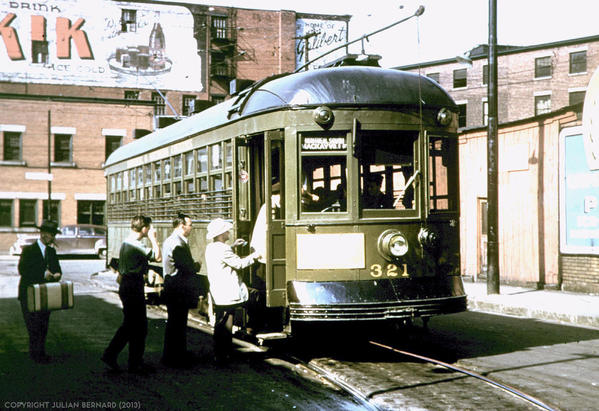 M&SC @ Montreal's McGill Street Terminal
M&SC @ Montreal's McGill Street Terminal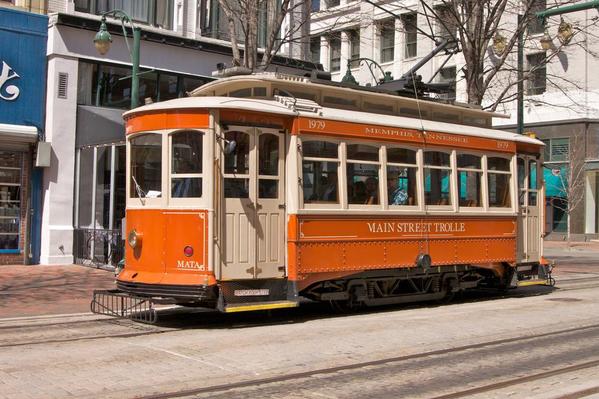 Memphis, Tennessee 1979
Memphis, Tennessee 1979 Philadelphia & Western Car @ Penn's Landing, 1990
Philadelphia & Western Car @ Penn's Landing, 1990
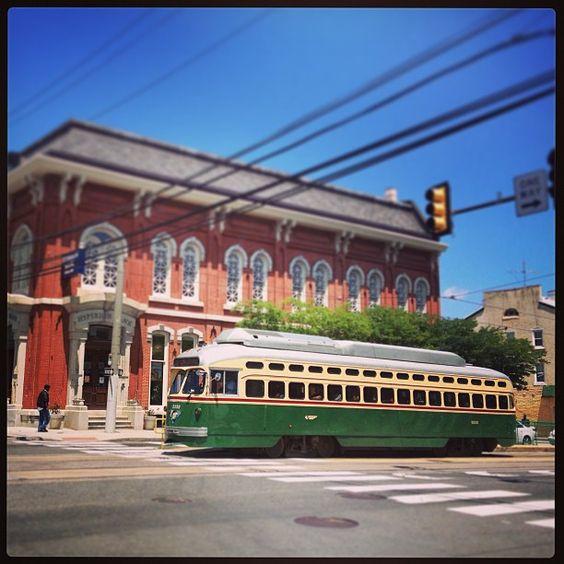 Current Picture of Car In Philadelphia, Pa
Current Picture of Car In Philadelphia, Pa
Car In Philadelphia, Pa Third Avenue Railway Car in Kennebunk Museum
Third Avenue Railway Car in Kennebunk Museum
Lets see your color photos of street cars and interurbans.
Attachments
Bobby Ogage posted:Some color photos of trolley cars.
Car In Pittsburgh, Pa
.
Hi Bobby:
Nice photos but are you sure that Route 79 green & white car #4043 is from “Pittsburgh, PA”? If so, can you please provide more info on it?
Thanks,
Bill
WftTrains posted:Bobby Ogage posted:Some color photos of trolley cars.
Car In Pittsburgh, Pa
.
Hi Bobby:
Nice photos but are you sure that Route 79 green & white car #4043 is from “Pittsburgh, PA”? If so, can you please provide more info on it?
Thanks,
Bill
Bill
He (Bobby) is incorrect. That is a Philadelphia PA., 4000 series streetcar of the Phila. Transportation Company (see the PTC Logo on car side under 2nd window) on route 79 in the early to mid 1950's "simplified modernized" paint scheme.
Seems more people post and look at photos on this endless thread of all these various prototype trolleys than actually do any hands-on construction and modeling of trolleys - and posting their photos of such modeling efforts, in this subways-traction forum section !!
regards - Joe F
Joseph Frank posted:WftTrains posted:Bobby Ogage posted:Some color photos of trolley cars.
Car In Pittsburgh, Pa
.
Hi Bobby:
Nice photos but are you sure that Route 79 green & white car #4043 is from “Pittsburgh, PA”? If so, can you please provide more info on it?
Thanks,
Bill
Bill
Bill, he is incorrect. That is a Philadelphia PA., 4000 series streetcar of the Phila. Transportation Company (see the PTC Logo on car side under 2nd window) on route 79 in the early to mid 1950's "simplified modernized" paint scheme.
Seems more people post and look at photos on this endless thread of all these various prototype trolleys than actually do any hands-on construction and modeling of trolleys - and posting their photos of such modeling efforts, in this subways-traction forum section !!
regards - Joe F
Joe:
Thanks for confirming what I thought as that car didn’t look familiar at all to this Pittsburgh streetcar enthusiast.
Bill
Here is some info on the Third Avenue car #631 from the Kennebunkport Seashore Trolley Museum:
"...A number of the relatively new cars were sent to the rescue of the ravaged Vienna System under the Marshall Plan for the rebuilding of wartorn Western Europe. They served well on what is today one of the world's largest operating streetcar systems. No. 631, built in 1939 and renumbered 4216 in Vienna, came home to America and Seashore after new cars built in Austria began service in 1980."
Technical Information:
Manufacturer: Third Ave. Ry. Co.
Year: 1939
Item Type: City and Suburban Streetcar
Description: Lightweight
| Operation: Double-ended | Seats: 46 |
Control: K-35 (LB)
| Trucks: 2 Brill 77E | Motors: 4 Westinghouse 510A |
| Brakes: Self Lapping | Compressor: CP-27 |
| Length: 42' 7" | Width: 8' 4" | Height: 11' 4" | Weight: 37540 lbs. |
Tom
WftTrains posted:Joseph Frank posted:WftTrains posted:Bobby Ogage posted:Some color photos of trolley cars.
Car In Pittsburgh, Pa
.
Hi Bobby:
Nice photos but are you sure that Route 79 green & white car #4043 is from “Pittsburgh, PA”? If so, can you please provide more info on it?
Thanks,
Bill
Bill
Bill, he is incorrect. That is a Philadelphia PA., 4000 series streetcar of the Phila. Transportation Company (see the PTC Logo on car side under 2nd window) on route 79 in the early to mid 1950's "simplified modernized" paint scheme.
Seems more people post and look at photos on this endless thread of all these various prototype trolleys than actually do any hands-on construction and modeling of trolleys - and posting their photos of such modeling efforts, in this subways-traction forum section !!
regards - Joe F
Joe:
Thanks for confirming what I thought as that car didn’t look familiar at all to this Pittsburgh streetcar enthusiast.
Bill
I fixed the caption to a Philadelphia car. Thanks for the correction.
PRT Work Car Z-8

Maintenance cars.
 Chicago, Aurora & Elgin Line Car 11
Chicago, Aurora & Elgin Line Car 11
 Milwaukee Electric Ry & Transport Co
Milwaukee Electric Ry & Transport Co

Replacing Trolley Wire On The Hagerstown & Frederick In Maryland
Attachments
PRT Emergency Car K-5

P&W Dump Car

Hershey Transit Construction Car 1933

Altoona & Logan Valley work flat motor

Wisconsin Traction Light, Heat & Power Co. of Appleton, WI Work flat with a load of gravel........and a few of the lads

Here are a few shots and a video from the Trolley Museum in Washington County PA...
Hey Google Image Searcher...I took these...saved you some time.
Attachments
Wisconsin Traction Light, Heat & Power Co. of Appleton, WI Work flat

Attachments
Thanks for the diagrams and info. I have a question for the trolley experts. The Pittsburgh PCC cars had a long metal piece between the wheels that slid along just above the top of the rail. I was told year go that this was an electromagnetic brake that would clamp on the top of the rail. True ??
The sliding brake between the wheels was also a primary service brake on some city trolley cars.
From repeated stopping at car stops, the rails would get bumpy from wear. This is one reason why trolley companies had rail grinders. Another reason was to smooth flash welds at rail joints.
Line car and a car with a load of ties

Oneonta, New York was a significant interurban hub borne out by the fact that many railways had Oneonta in the names. Here are some images of Oneonta rolling stock of the Oneonta, Cooperstown & Mohawk Valley, and the Oneonta & Mohawk Valley.
I am puzzled by the "United States Express" logo on the cars. Did tis mean they carried the US Mail?
Attachments
Bobby Ogage posted:I am puzzled by the "United States Express" logo on the cars. Did tis mean they carried the US Mail?
Yup! And/or REA - Railway Express Agency
Prior to World War One there were many regonal express companies. During the war they were consolidated into a single company and were run by the government, just like the railroads were. But at the end of the war, unlike the railroads, the express companies were left consolidated under the name American Railway Express. ARE went bankrupt within about 10 years and was sold by the bankruptcy court. It was purchased by a group of railroads and renamed Railway Express Agency. When you see names on cars like United States Express, this in an indication that the picture is from prior to WW1, when the express companies were consolidated.
Single end dump car

That single end dump car could be made from an MTH Rail King operating log dump car.

Attachments
Bobby Ogage posted:That single end dump car could be made from an MTH Rail King operating log dump car.
Decent enough bit of raw materials to get a start with - have to scratch together that cab.
Or..........you could just start with the Ashland or Copetown kit.
Building the car might be the easiest bit - a fully under the floor drive might be a bit of a challenge - 2 rail ones from Q-car will work, but 3-rail is something else....
rex desilets posted:NWSL Stanton drive
But, where do you get the sideframes and will this drive even accept them?
Seen in the Pittsburgh Rwys Castle Shannon Car Yard

mwb posted:rex desilets posted:NWSL Stanton driveBut, where do you get the sideframes and will this drive even accept them?
Q Car no longer sells sideframes?
How about their unpowered trucks?
Combining is an exercise left to the student.
rex desilets posted:mwb posted:rex desilets posted:NWSL Stanton driveBut, where do you get the sideframes and will this drive even accept them?
Q Car no longer sells sideframes?
How about their unpowered trucks?Combining is an exercise left to the student.
Quentin stopped selling sideframes several years ago. ![]() Stopped selling most if not all components for trucks.
Stopped selling most if not all components for trucks.
I guess you can still get assembled trucks (not sure...) and disassemble them for the parts.![]()
Still, mating them to that drive is an unknown. So, get to work on that and let us all know how it turns out now, will you? ![]()
![]()
mwb posted:rex desilets posted:mwb posted:rex desilets posted:NWSL Stanton driveBut, where do you get the sideframes and will this drive even accept them?
Q Car no longer sells sideframes?
How about their unpowered trucks?Combining is an exercise left to the student.
Quentin stopped selling sideframes several years ago.
Stopped selling most if not all components for trucks.
I guess you can still get assembled trucks (not sure...) and disassemble them for the parts.
Correspondence with Quentin indicatedStill, mating them to that drive is an unknown.
Quote from catalog: "The rigid plastic body is made from ABS, allowing you to glue, drill and tap, or otherwise attach what you’ve got."
Also, there's the NWSL Flea, which would fit into any truck.So, get to work on that and let us all know how it turns out now, will you?

Way, way down in my queue. Besides, you're the trolley maven. I'm just a wannabe.
rex desilets posted:mwb posted:rex desilets posted:mwb posted:rex desilets posted:NWSL Stanton driveBut, where do you get the sideframes and will this drive even accept them?
Q Car no longer sells sideframes?
How about their unpowered trucks?Combining is an exercise left to the student.
Quentin stopped selling sideframes several years ago.
Stopped selling most if not all components for trucks.
I guess you can still get assembled trucks (not sure...) and disassemble them for the parts.
Correspondence with Quentin indicatedStill, mating them to that drive is an unknown.
Quote from catalog: "The rigid plastic body is made from ABS, allowing you to glue, drill and tap, or otherwise attach what you’ve got."
Also, there's the NWSL Flea, which would fit into any truck.So, get to work on that and let us all know how it turns out now, will you?

Way, way down in my queue. Besides, you're the trolley maven. I'm just a wannabe.
Last I looked you could still order entire trucks from Quentin; just have not looked nor needed any parts for any project.
ABS is not a plastic that is all that friendly but it is workable -- what I was questioning more was the wheelbase of the sideframes vs. the drive's.
And my kits for the Difco differential dump cars are slowly rising to the front of the project queue, but fortunately for me I already have the Q-car drives in hand for those cars, ![]()
I've got 4 different trolley projects on my work benches right now, and when they are done and written up, then it's back to freight cars for a while; got a stack of styrene air slide hoppers to restore, rebuild and just build......and then sell them all off.
Single Truck Oil or water sprinkler car

Carrying a few new poles for the line........
So a fellow buys some buildings in El Cajon a few years back, but not just any buildings. Under the vinyl siding and sheet rock, the main structure consists of the last three San Diego Class 1 streetcars known to exist.
Designed in 1910 and built by the St. Louis Car company, these were the first double truck streetcars on the San Diego Electric Railway. They were built to carry passengers to the Panama Exposition in what is now Balboa Park.
After they were retired, many were used to make affordable houses. One house, built of the three streetcars, survived. Under the covering, the gold leaf and cherry trim was beautifully preserved.
More info is here: http://sandiegohistoricstreetcars.org/
Attachments
Dump Car with load of dirt and then dumping it......


mwb posted:Dump Car with load of dirt and then dumping it......
This is actually the first time I've seen a Differential Dump Car doing what it was designed to do, i.e dump loads from either side of the car!
Neato!
Mitch
I have two Standard gauge #218 dump cars that do that. They are heavy !!
Trolleys on Main Street, Memphis, TN:

Tomlinson Run Railroad
Attachments
And here’s another type of dump car built by the Differential Car Company. This car dumps directly downward (like a hopper car) and is used for spreading ballast along private trolley right-of-ways. This car was originally built for the Boston Elevated Railway in 1927 and was acquired by the Pennsylvania Trolley Museum in 1974.
It was restored by the PTM and still serves its original purpose as shown in the attached photo being loaded with ballast during construction of PTM’s Redman Wye trackage a few years ago. And if that name sounds familiar, that trackage was named for that very same Lou Redman, a co-founder of the PTM as well as a founding member of the TCA.
(Photo courtesy of the PTM website)
Bill
Attachments
Nate posted:Third Avenue Railway Differential car co side dump. Built from old Miller car co kit. Q Car trucks and motors. The kits are still to be found in the usual places if you look.
Nice looking model!
Crane flat motor......

Attachments
Wilkes-Barre Pa Rwy Snow Blower 030

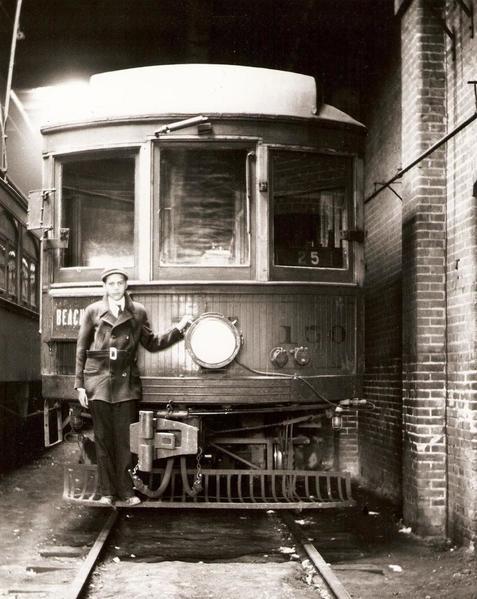 Lake Shore Electric???
Lake Shore Electric???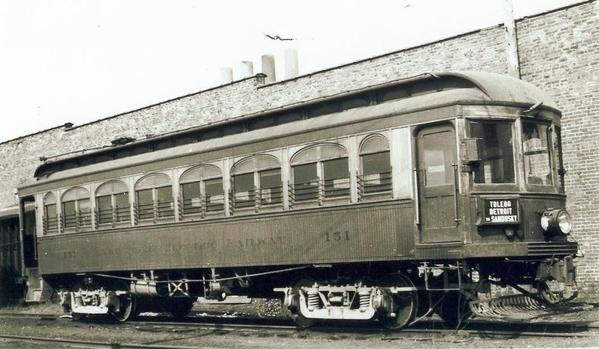 Lake Shore Electric????
Lake Shore Electric????
 Norristown, Lehigh Valley????
Norristown, Lehigh Valley???? Missoula Montana
Missoula Montana ?????????
????????? Walla_Walla?????
Walla_Walla????? Baltimore
Baltimore
Attachments
2 Truck oil motor..........

Rhode Island had a significant trolley car system. #61 is a 29 foot, 30 seat single truck car built by Jones in 1893 with open platforms
#61 is a 29 foot, 30 seat single truck car built by Jones in 1893 with open platforms
 #1070 WAS A 41-FOOT CAR BUILT BY BRADLEY IN 1911
#1070 WAS A 41-FOOT CAR BUILT BY BRADLEY IN 1911
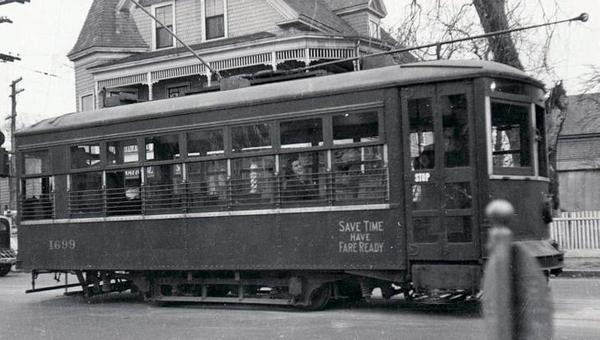 #1699 WAS A 30-FOOT SINGLE TRUCK SAFETY CAR BUILT BY BRADLEY IN 1922
#1699 WAS A 30-FOOT SINGLE TRUCK SAFETY CAR BUILT BY BRADLEY IN 1922
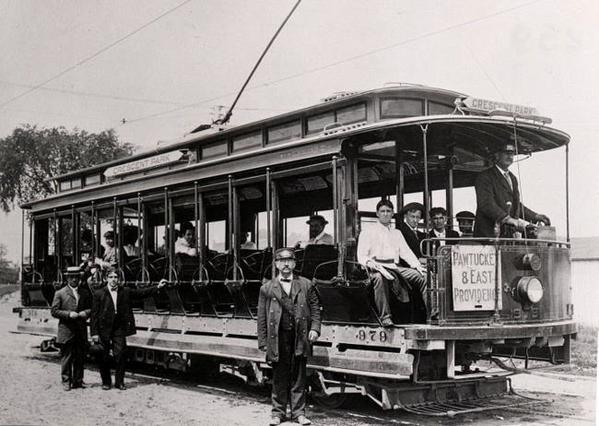 AT RIVERSIDE IN 1910 ON LINE TO CRESCENT PARK AMUSEMENT PARK
AT RIVERSIDE IN 1910 ON LINE TO CRESCENT PARK AMUSEMENT PARK
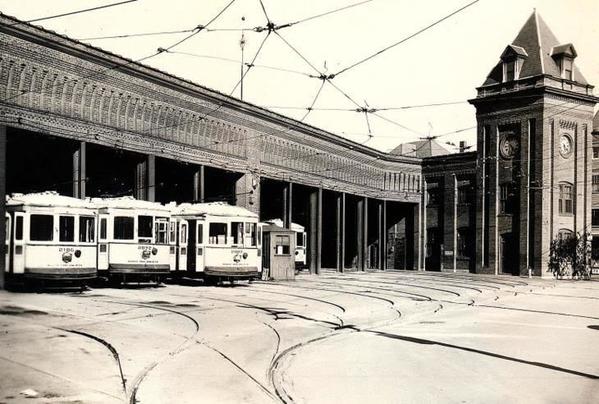 BROAD STREET CAR HOUSE AT THURBERS AVENUE, PROVIDENCE
BROAD STREET CAR HOUSE AT THURBERS AVENUE, PROVIDENCE
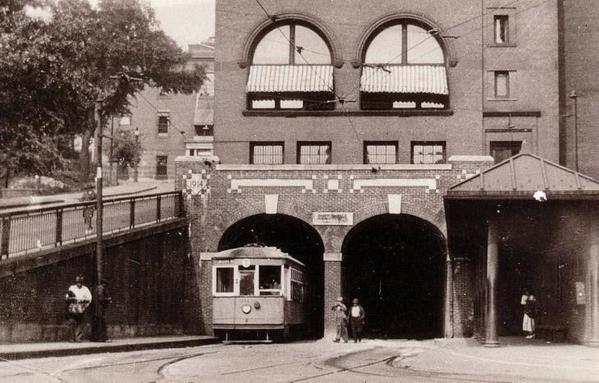 EAST SIDE TUNNEL UNDER The Rhode Island School of Design, COLLEGE HILL, PROVIDENCE
EAST SIDE TUNNEL UNDER The Rhode Island School of Design, COLLEGE HILL, PROVIDENCE

50 UER CARS WERE SOLD TO CAPITAL TRANSIT OF WASHINGTON, D.C. IN 1940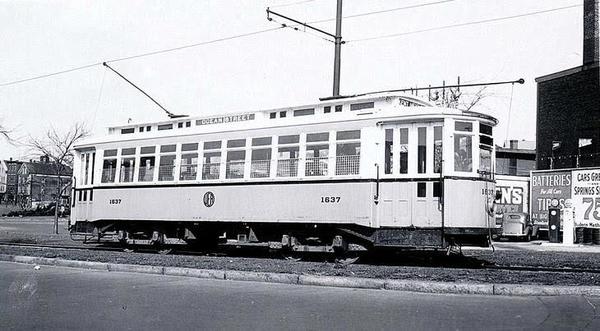 KENT HEIGHTS ON FOX POINT BOULEVARD, PROVIDENCE
KENT HEIGHTS ON FOX POINT BOULEVARD, PROVIDENCE

 RHODE ISLAND 2113 IS A 41 FOOT LONG SAFETY CAR
RHODE ISLAND 2113 IS A 41 FOOT LONG SAFETY CAR
Attachments
FJ&G snow sweeper....... Winter is coming!

Another on the FJ&G

Some random images of trolley cars.
 Denver trolley car on Casper Mountain, Colorado
Denver trolley car on Casper Mountain, Colorado
Southington, Montana
Syracuse, New York
 Wellsburg, New York
Wellsburg, New York
Attachments
Scranton Rwys sweeper 107

Lehigh Valley Transit Line car R2.........wish I had a 3/4 view from the other end!

Lehigh Vallet Transit Sweeper and Sand Car 524

On the Chambersburg and Gettysburg line....two trolleys leaving the car barn in Chambersburg, PA

C & G Trolley in Chambersburg, PA

Is that the museum in Spencer ??
jim pastorius posted:Is that the museum in Spencer ??
Yes, it is Jim. I recently went there to escape Irma and decided to turn this into a vacation. My family knows that I love trains and said that I should visit the North Carolina Transportation Museum in Spencer. That was a great suggestion and I also had to visit the Old Smoke Pit BBQ nearby.![]()
I thought I recognized it. I was there last summer with my son and we spent several hours there. My son suffered a stroke and was using a walker so that made it tough to get around. I am staying in the Raleigh area now but on the east side. The trip to Spencer is pretty long or I would be there more often. Hard to find a train around here. My son can't swallow so no BBQ or even a visit to the hobby shop.
Jim, So sorry to hear about your son's health problems, I wish him all the best.
C&G Trolley at Caledonia Park from Chambersburg in 1904

Odd trucks on that one...?
rex desilets posted:Odd trucks on that one...?
Indeed they are, and also I have no idea what kind they are either.
Could be St. Louis Car Co. trucks, though I'm willing to be told different. ![]()
Mitch















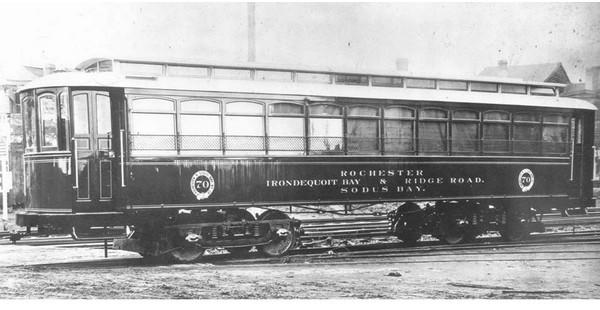
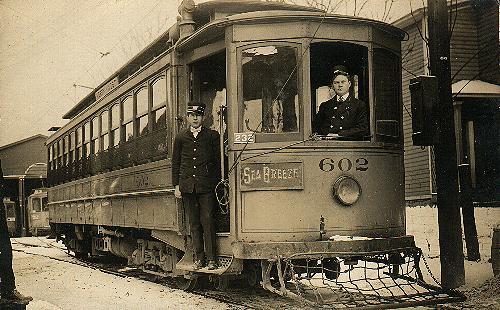






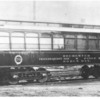












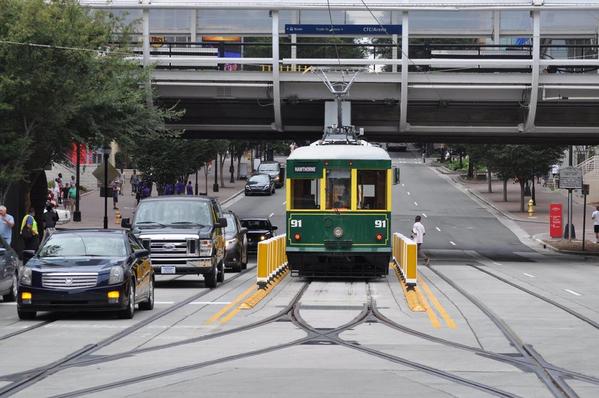
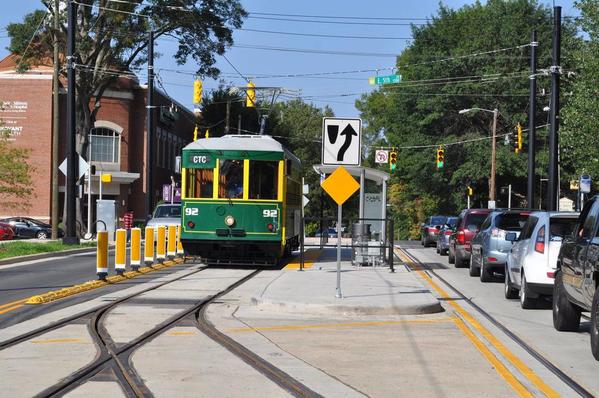

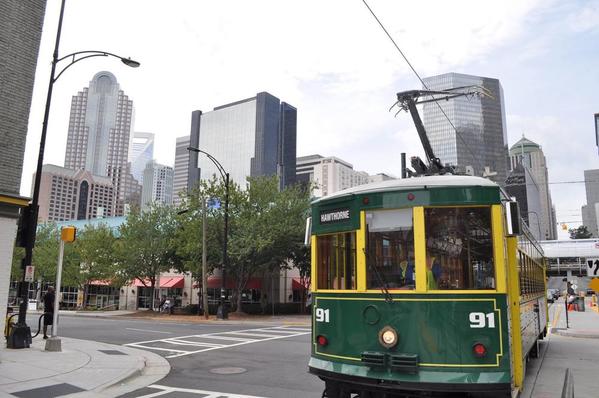





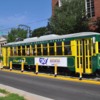

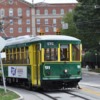

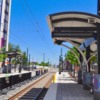



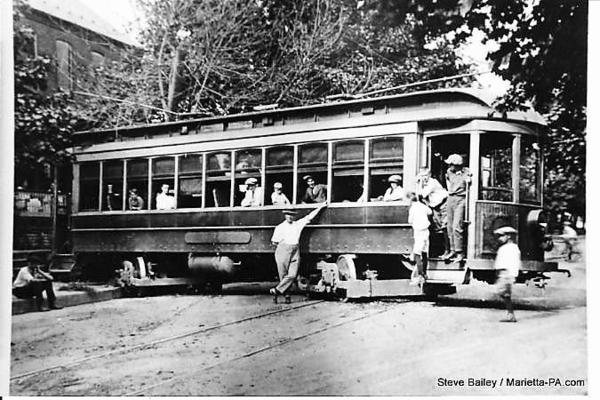









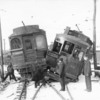


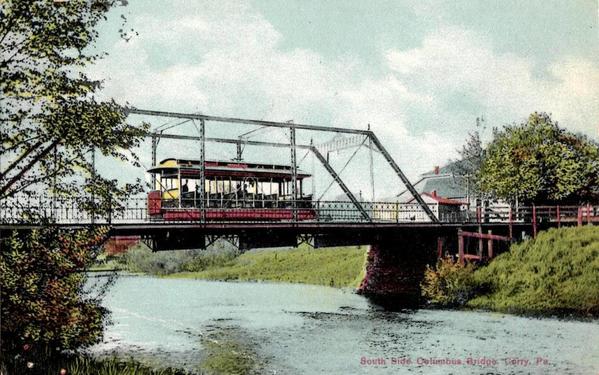





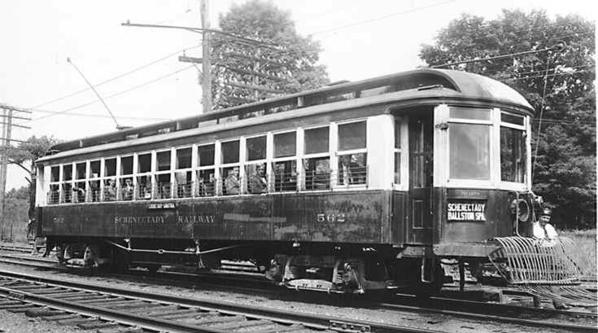








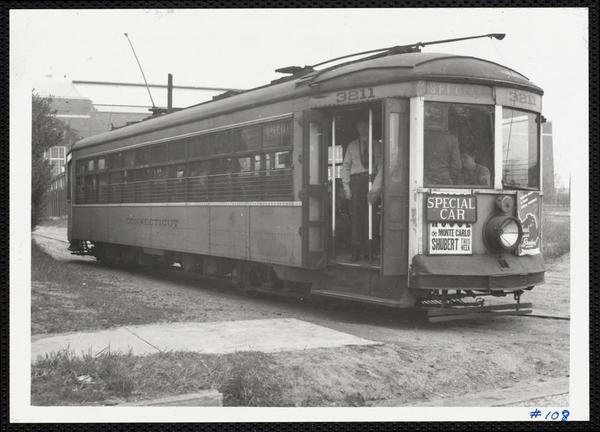

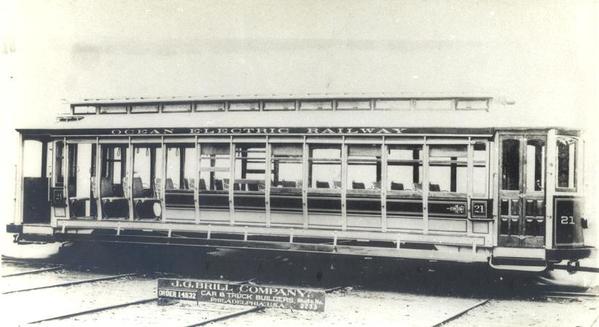
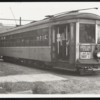
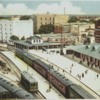

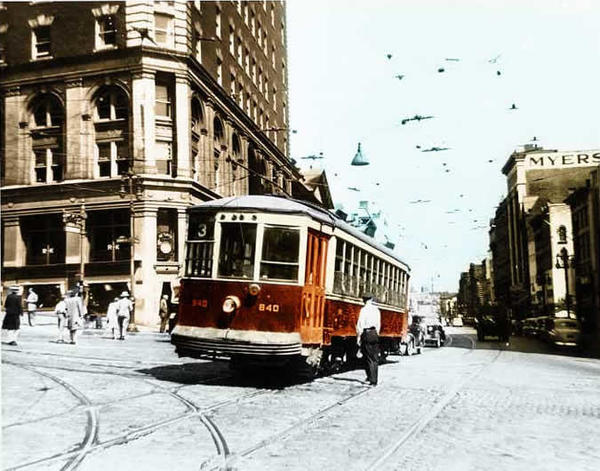
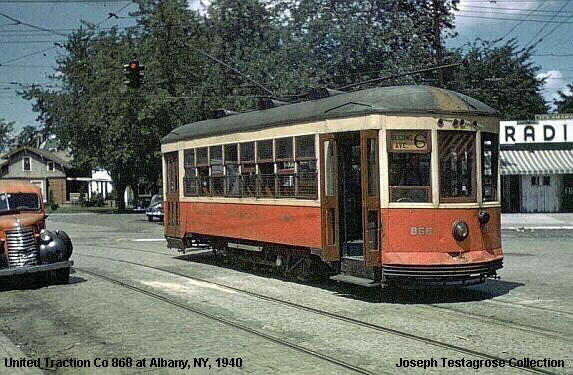
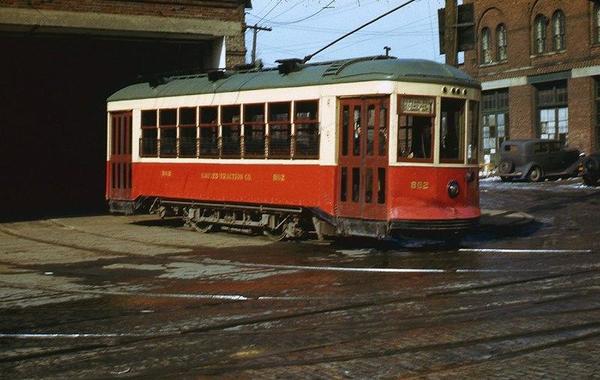






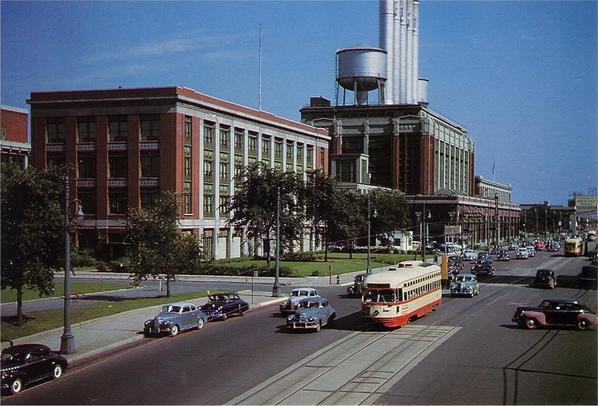
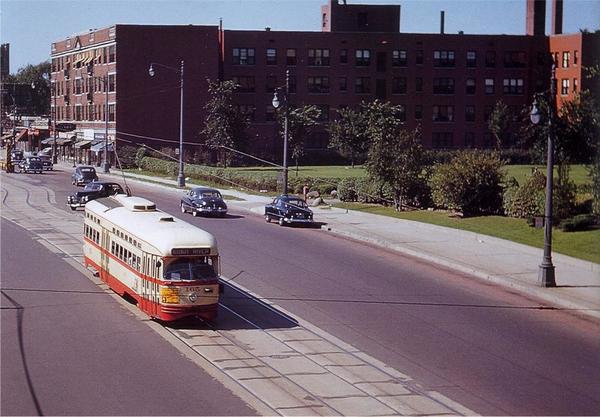
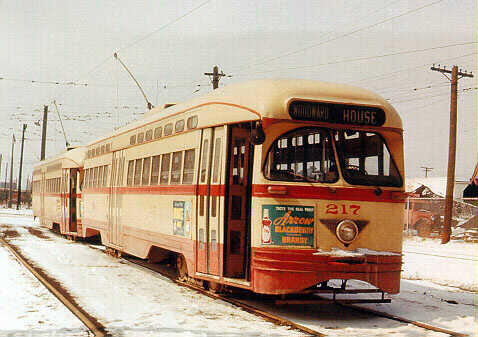
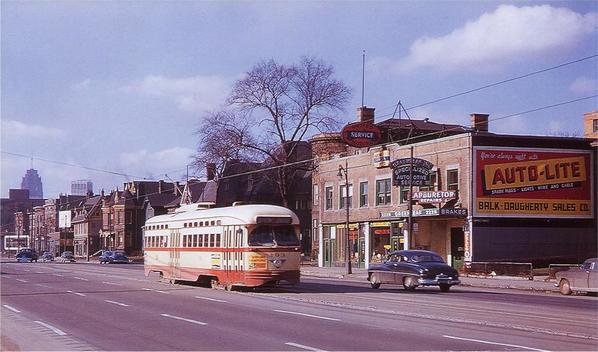
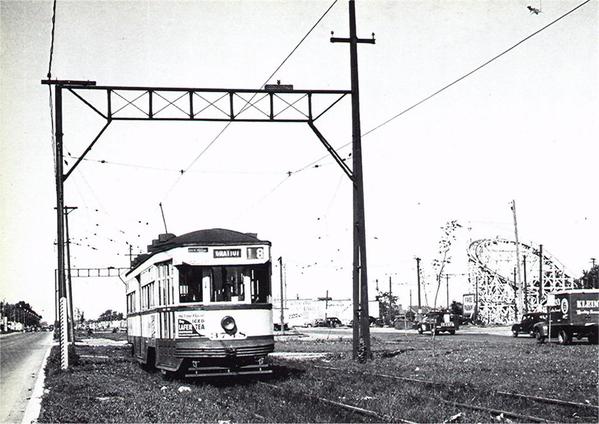
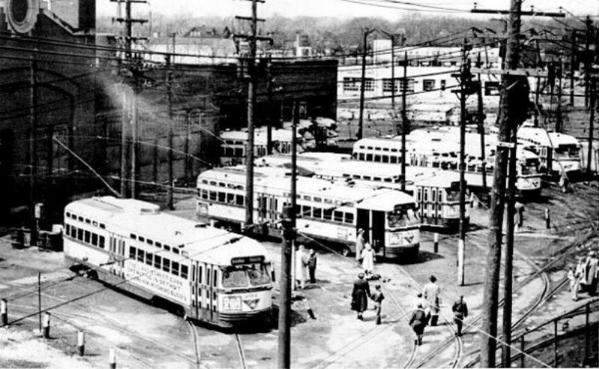
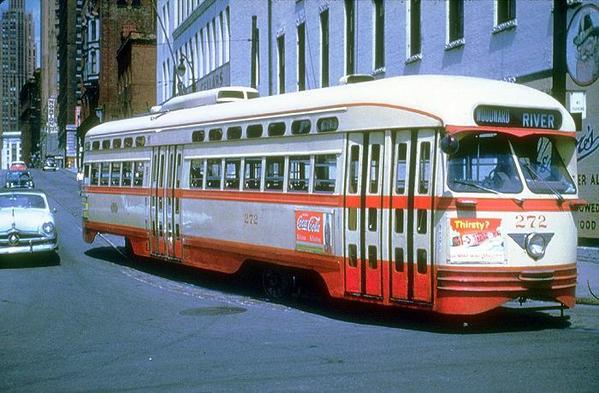
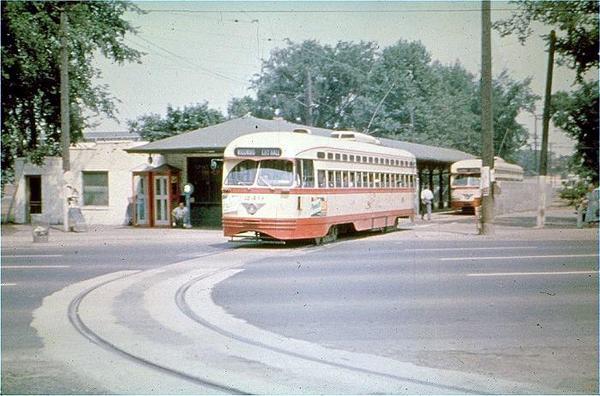
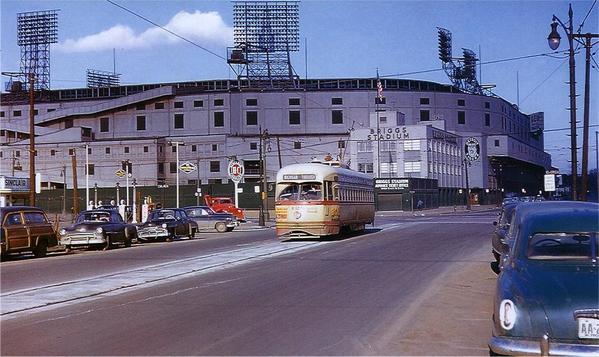


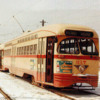
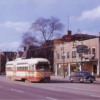
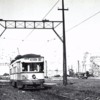


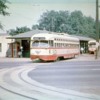

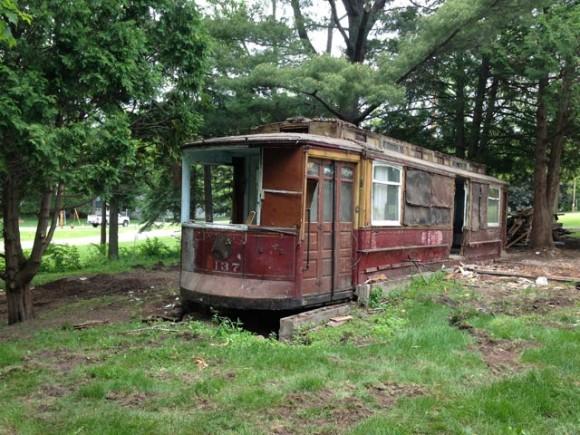
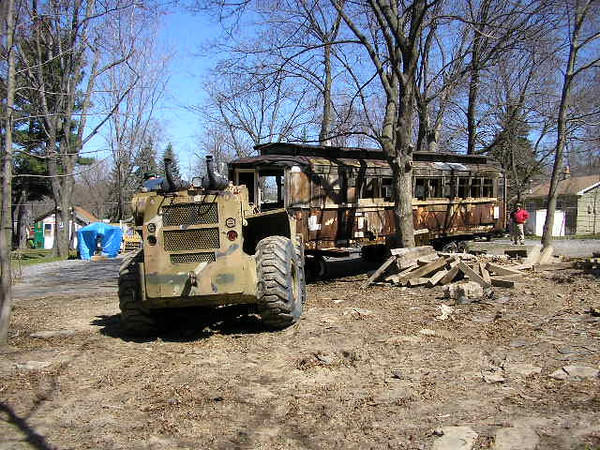
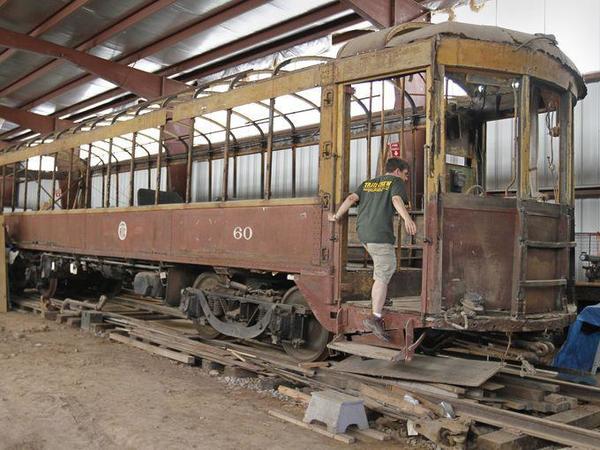
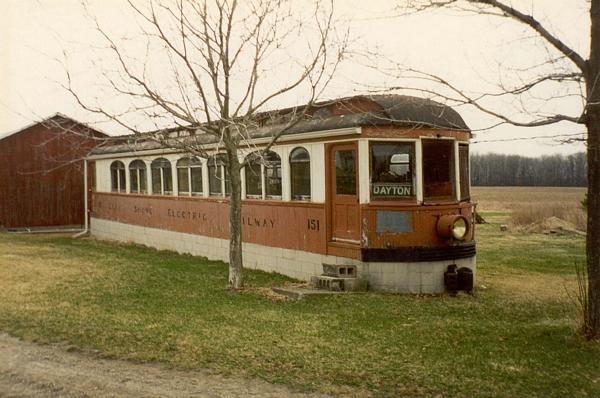
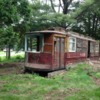
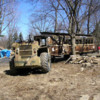

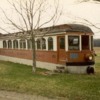
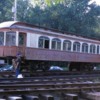
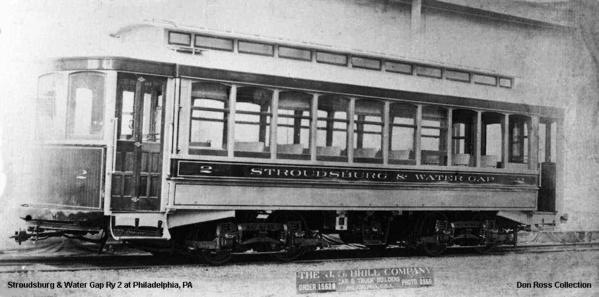
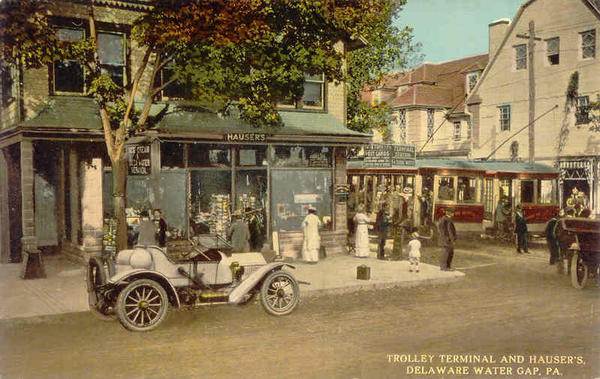
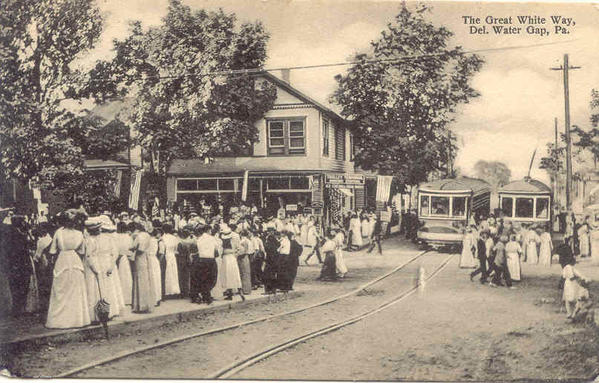
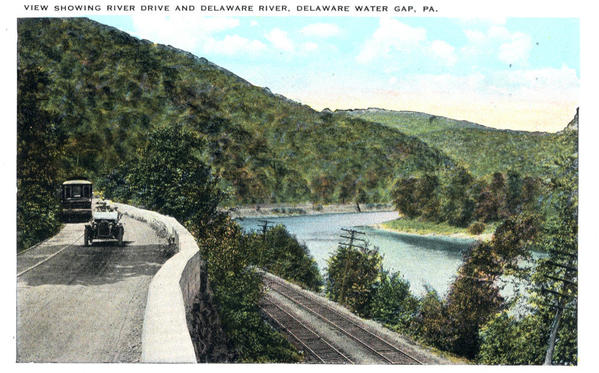
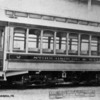
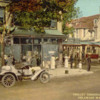
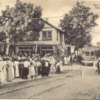

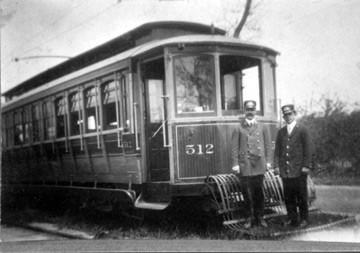
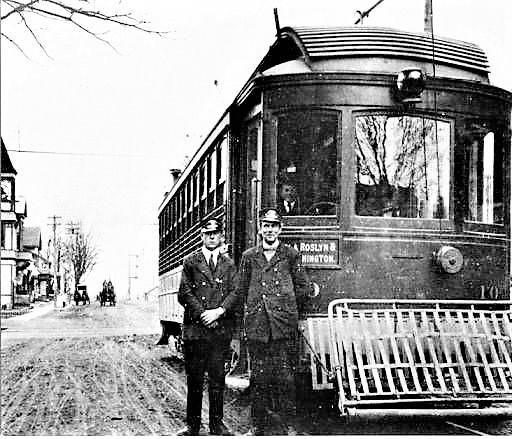
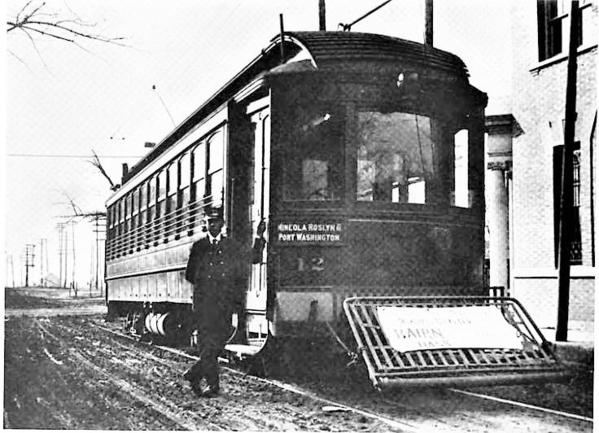
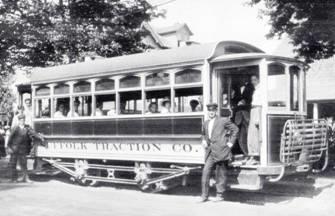
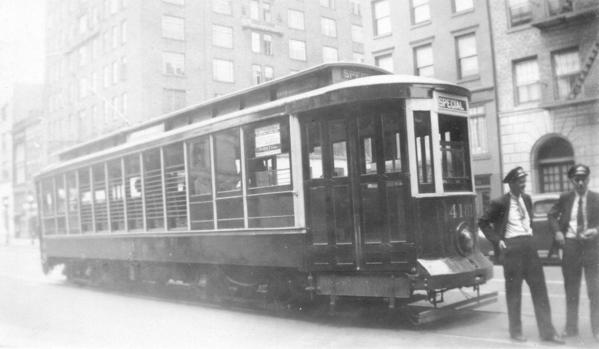

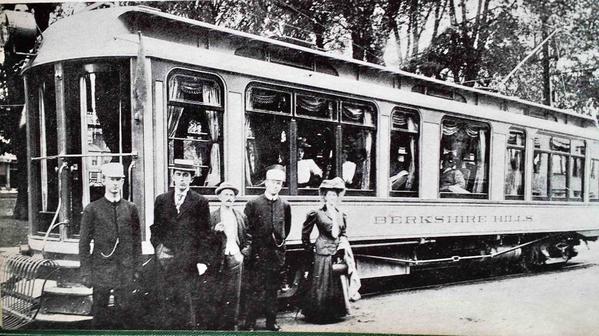
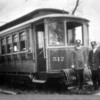
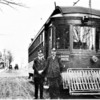
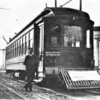
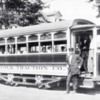
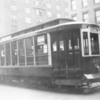

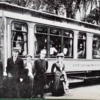
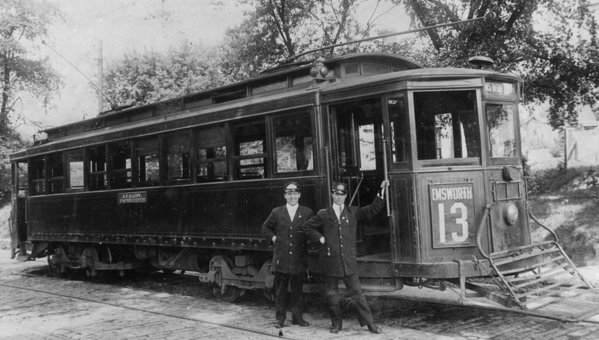
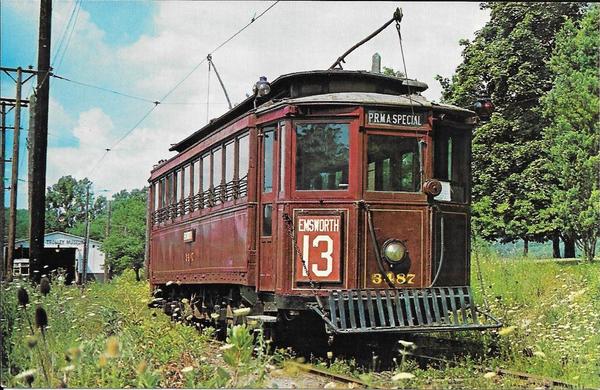

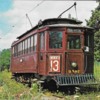
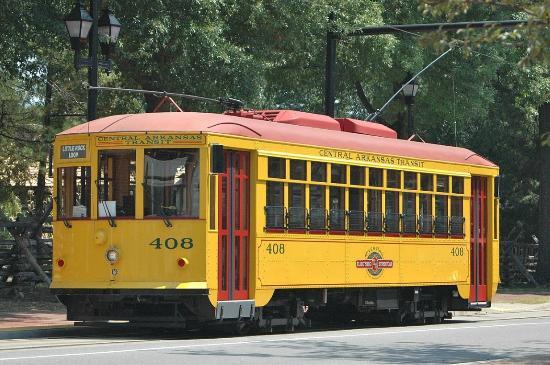


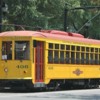

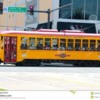
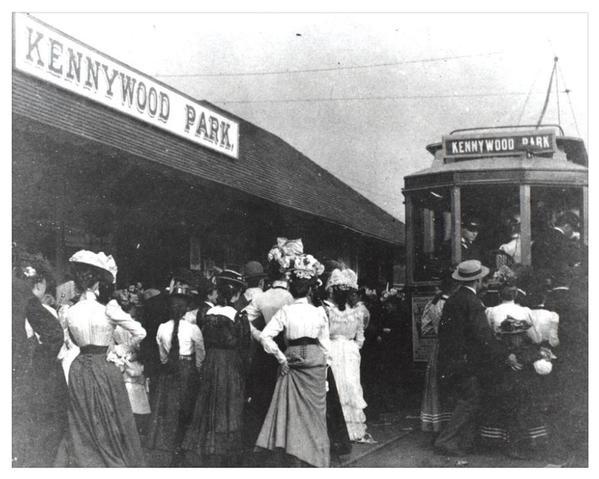
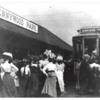
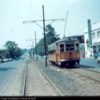
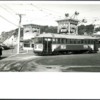
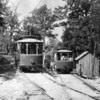
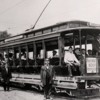
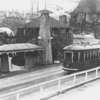
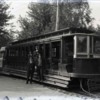
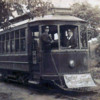
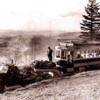
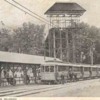










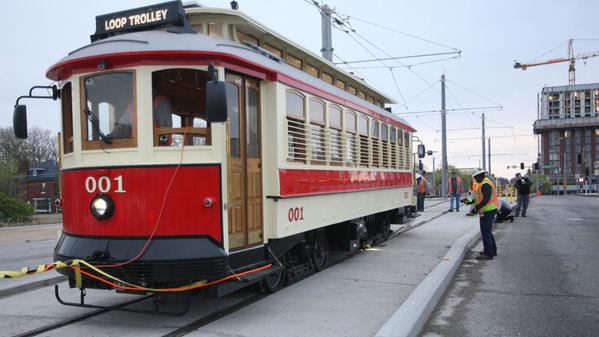

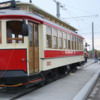
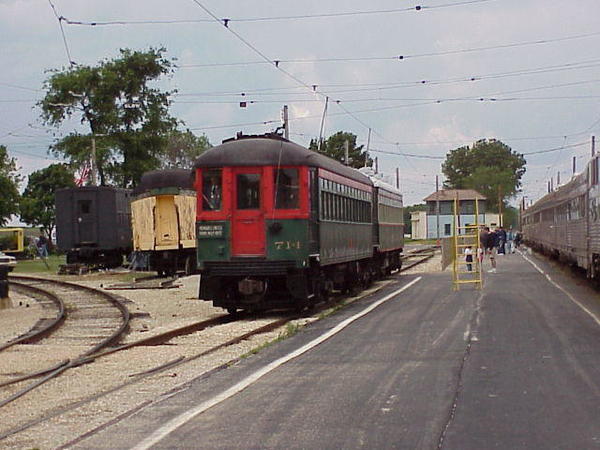
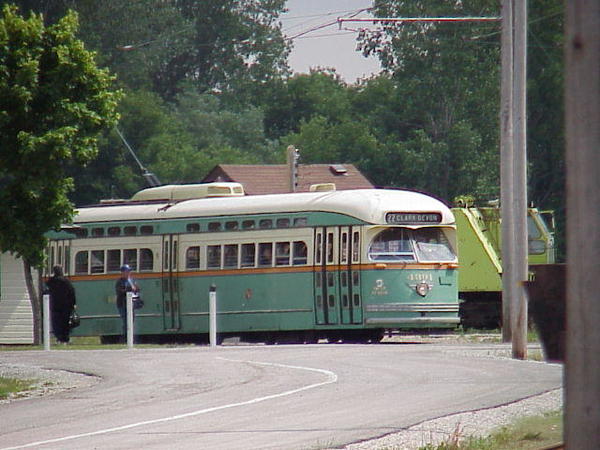
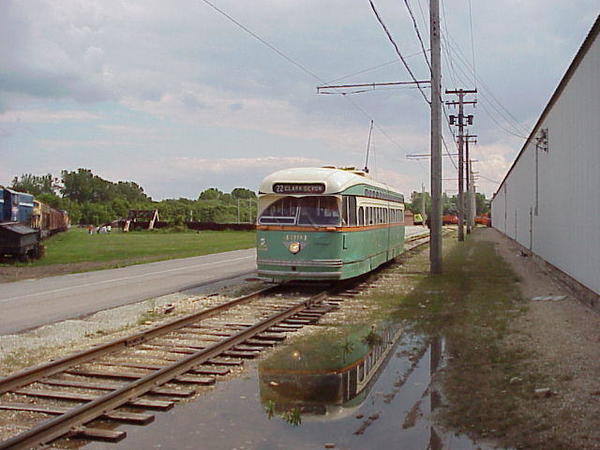
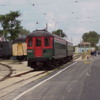
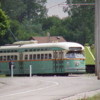



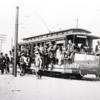
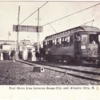
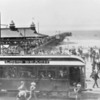

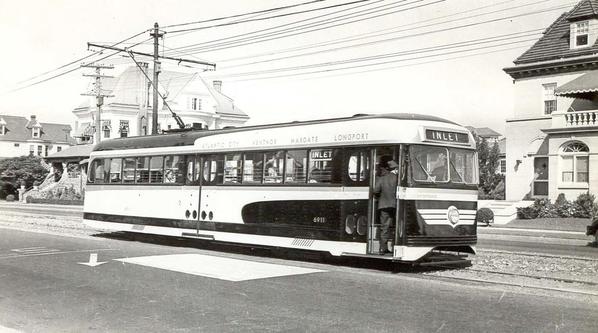
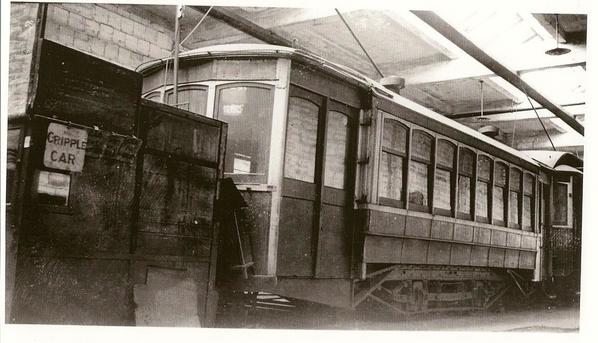
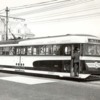
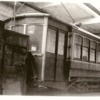
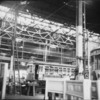
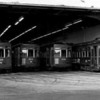


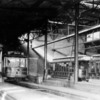
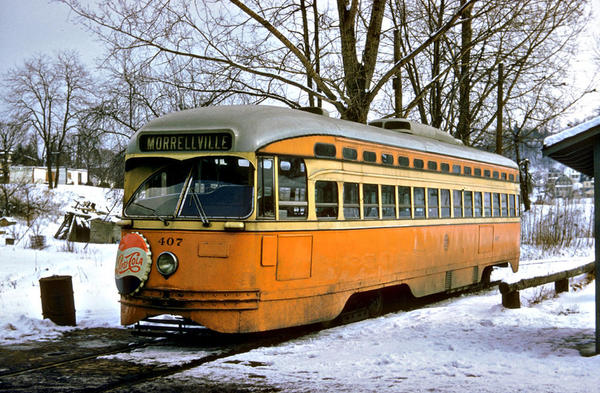

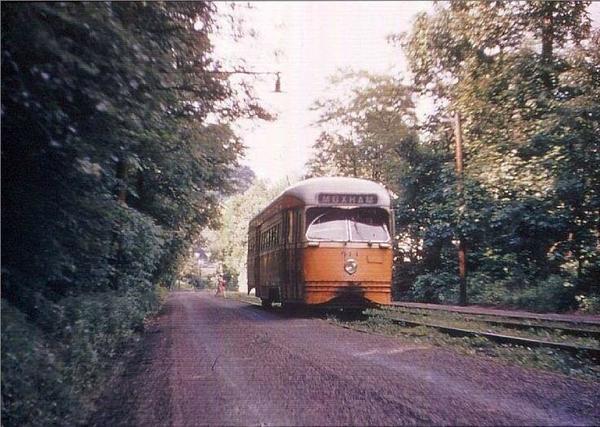

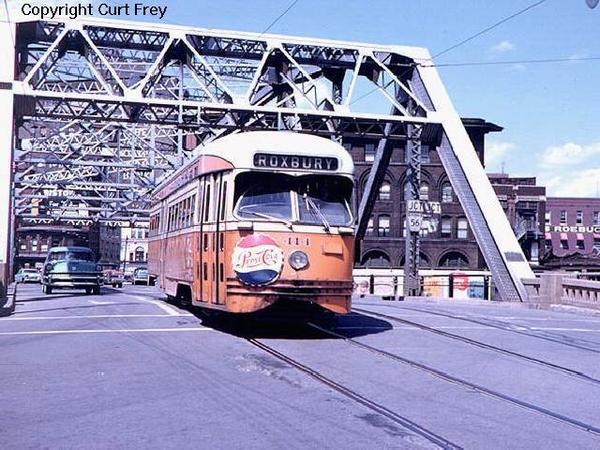
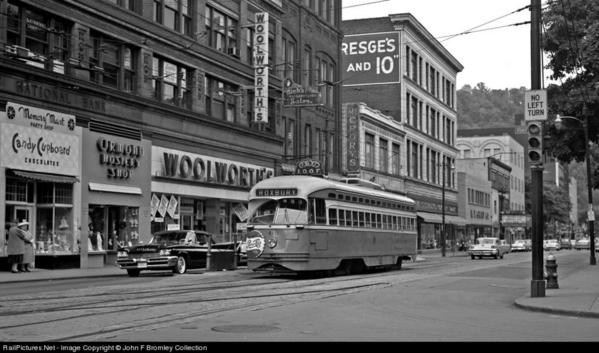

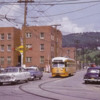


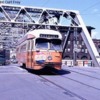
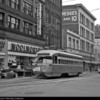















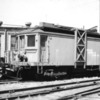
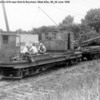








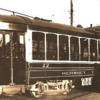


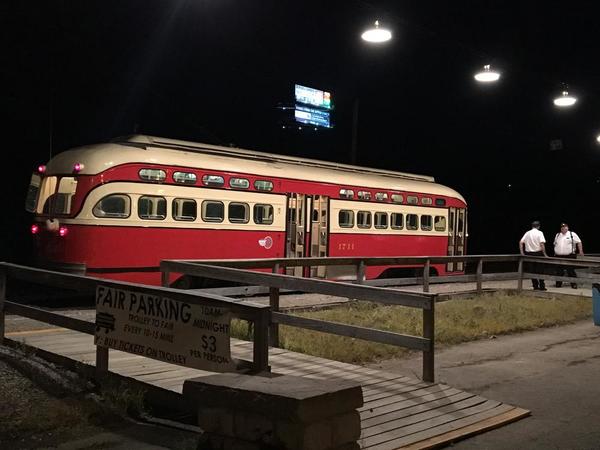

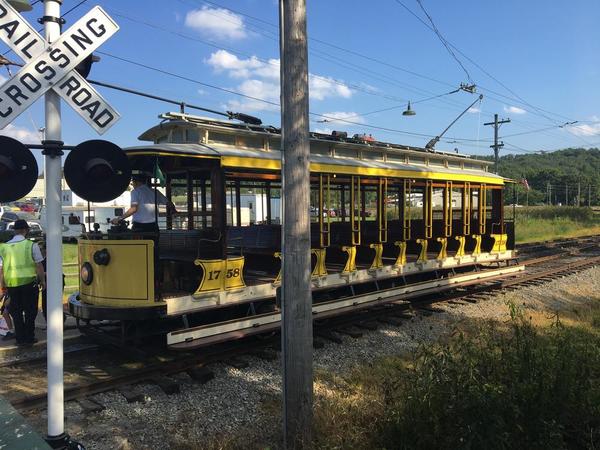






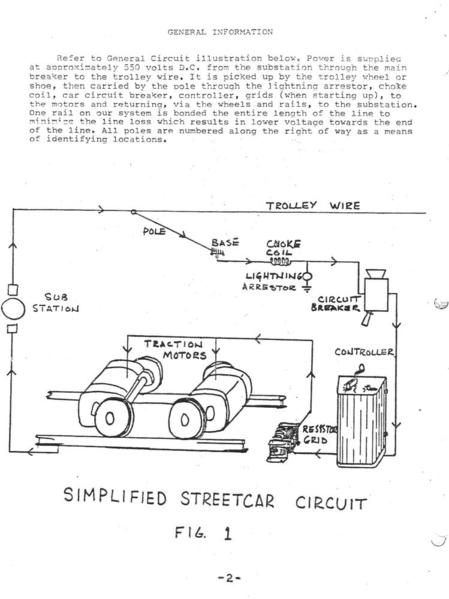



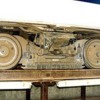

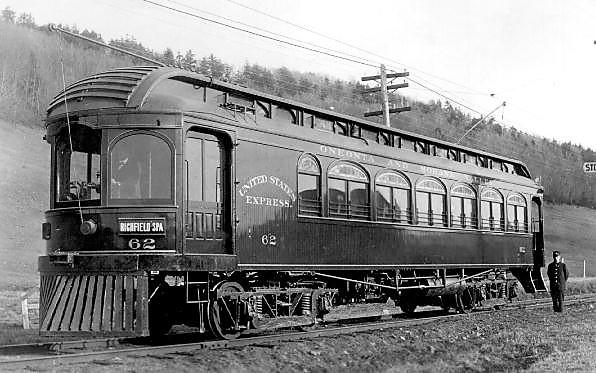
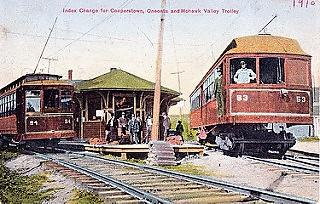


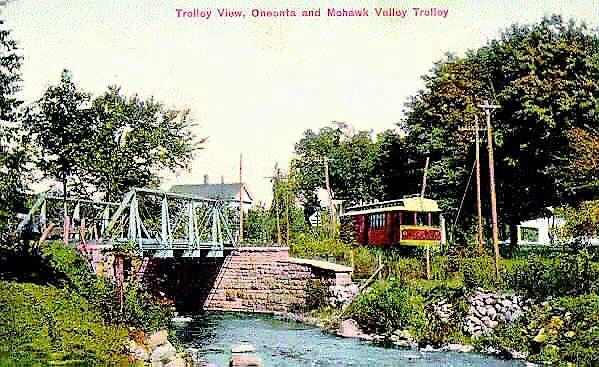





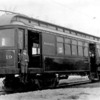




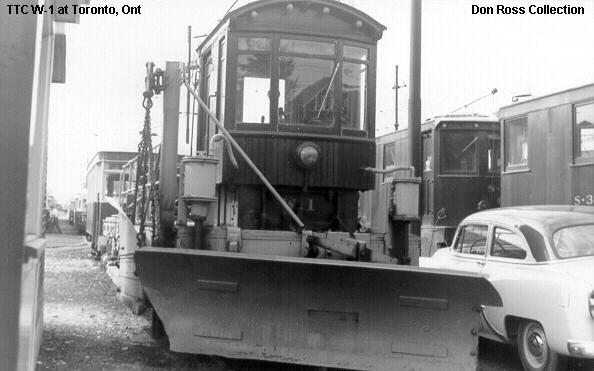
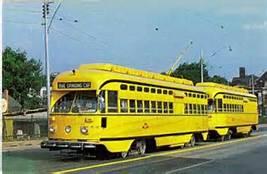



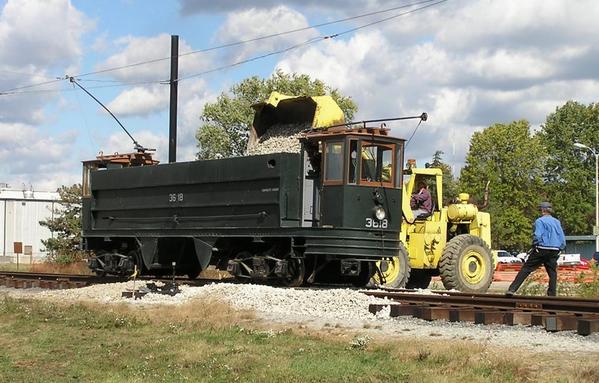






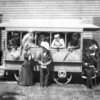


 Cincinnati
Cincinnati  Fort William Electric Railway
Fort William Electric Railway Lulu Island - Euburne Railway
Lulu Island - Euburne Railway





